Search Results for PRODUCTION
Explore AI generated designs, images, art and prompts by top community artists and designers.
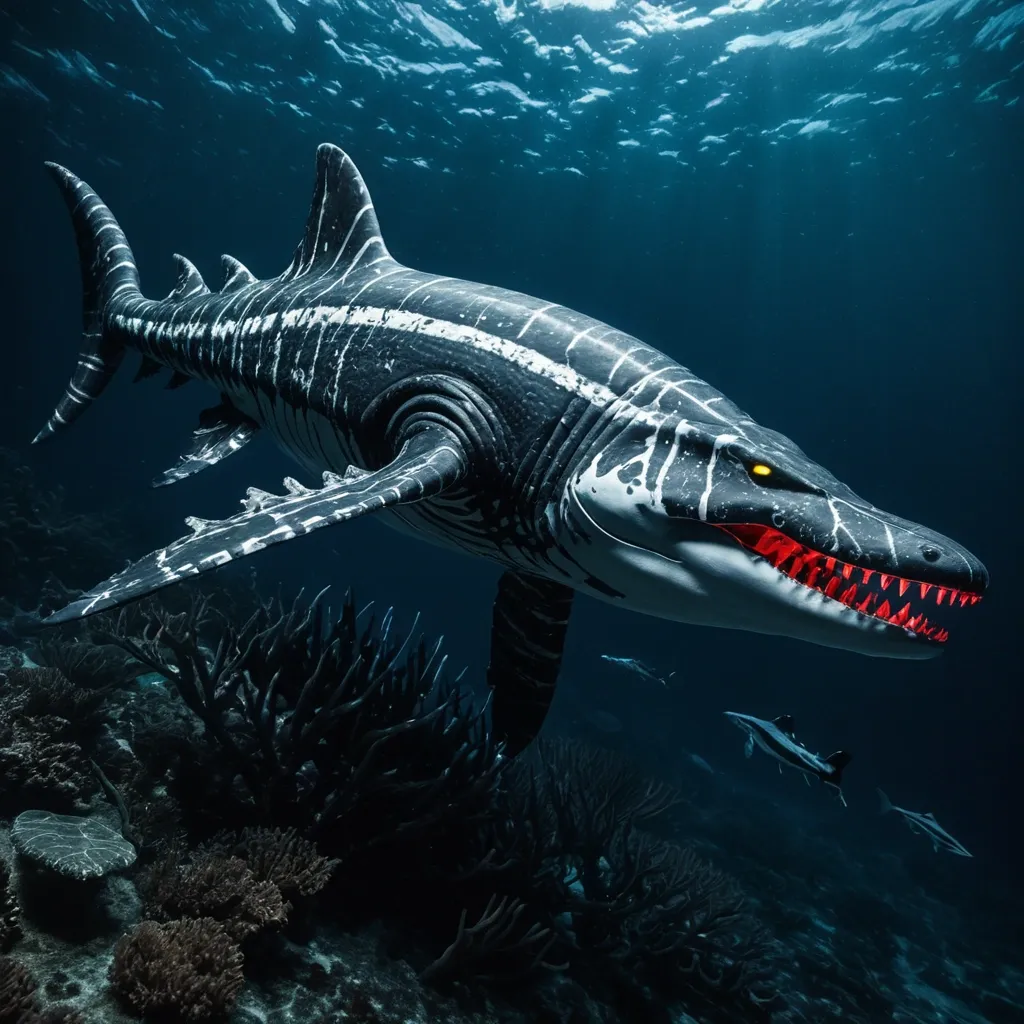
Megalosaurus Orca The Apex Hybrid of Oceanic Depths Physical Characteristics: Length: 40-60 feet Weight: 50-75 tons Lifespan: 100-135 years Coloration: Males: Jet black base with light gray tiger stripes Females: Slate gray base with white tiger stripes Bioluminescent red photophores arranged in tiger stripe patterns along the flanks and dorsal ridge , glowing vividly in abyssal darkness Body: Robust , muscular frame combining the thick , armored scales of saltwater crocodile with the hydrodynamic , flexible body of Mosasaurus Hoffmannii Fins: Large , rigid pectoral fins capable of tilting backward to reduce drag , inspired by the Black Marlin’s speed adaptations Limbs: Powerful flippers adapted for both swimming and short-distance land movement , similar to a leopard seal’s scooting style Jaw: Enormous , reinforced jaws with over 40 , 000+ PSI bite force , lined with long , razor-sharp canine teeth from Predator X and Megalodon genetics Skin: Coated with a thick mucus layer secreted like the Atlantic hagfish , providing parasite defense , moisture retention , and a slippery surface to evade predators and prey alike Respiratory system: Dual-function lungs and gills allow breathing in surface air and extracting oxygen from water , enabling survival from ocean surface to depths up to 9 , 800 feet Sensory: Passive listening capabilities from transient killer whale lineage enable near-silent hunting; bioluminescent photophores aid in communication and prey attraction in deep-sea darkness Abilities and Adaptations: Speed: Can burst up to 62-82 mph in water , rivaling the fastest sea creatures Salinity tolerance: Thrives in a wide range of water conditions , from freshwater estuaries to deep oceanic trenches , thanks to Mexican molly and saltwater crocodile genetics Regeneration: Limb and tissue regeneration inspired by axolotl traits , allowing recovery from injuries sustained during hunting or territorial battles Social structure: Lives in small , tight-knit family groups (1 male , 2 females) for efficient hunting and offspring rearing , reflecting transient killer whale social dynamics Reproduction: Live births occur at abyssal depths (~9 , 800 feet) , with offspring born adapted to extreme pressure and cold; males are streamlined for speed and power , while females are larger and more robust for nurturing and endurance Communication: Uses bioluminescent patterns and low-frequency vocalizations for mating displays , intimidation , and coordination during hunting Defense: Venomous spines inspired by the crown-of-thorns starfish line the dorsal ridge , delivering painful wounds to predators or rivals Hunting: Stealthy predator using passive listening to locate marine mammals and large prey; can leap and strike with explosive power , aided by shortfin mako shark agility and predator X bite force Backstory: Created in the secretive labs of Ceno Evail Crossgen Corporation , the Megalosaurus Orca was engineered as the ultimate marine apex predator , combining the might of prehistoric giants with the cunning and adaptability of modern ocean hunters. Designed to dominate a range of aquatic environments from sunlit coasts to the crushing abyss , these hybrids serve both as a scientific marvel and a living weapon for deep-sea exploration and control. The trio—one male and two females—are monitored closely , their social bonds and hunting strategies studied to unlock secrets of marine dominance and survival. Their ability to navigate and thrive across extreme depths , combined with their regenerative powers and venomous defenses , make them nearly invincible in their domain. ,
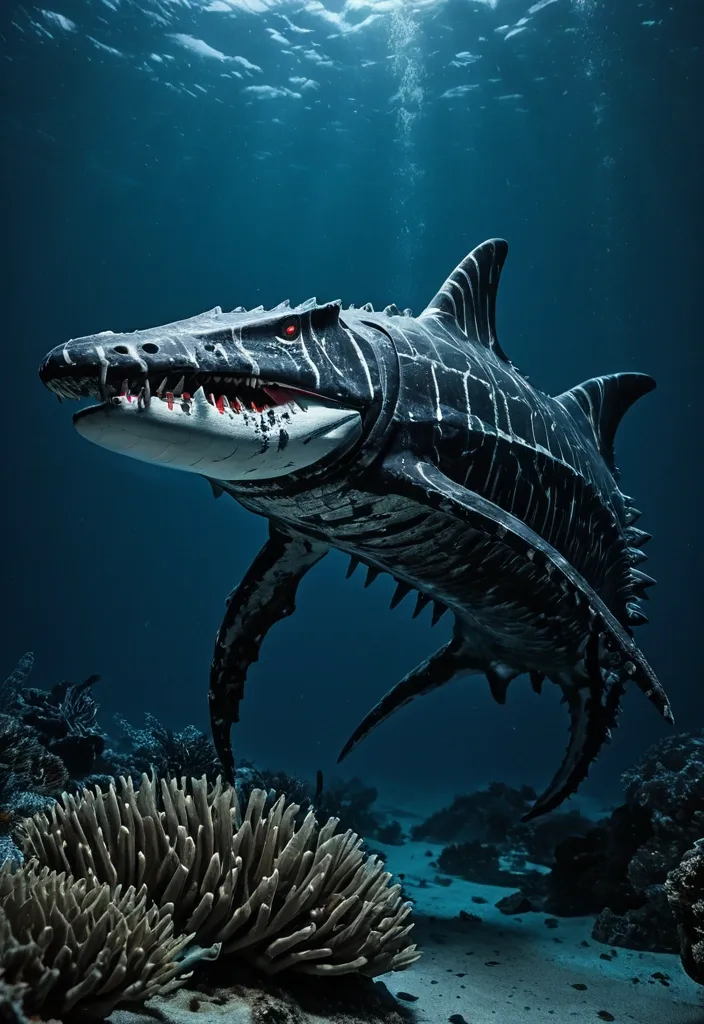
Megalosaurus Orca The Apex Hybrid of Oceanic Depths Physical Characteristics: Length: 40-60 feet Weight: 50-75 tons Lifespan: 100-135 years Coloration: Males: Jet black base with light gray tiger stripes Females: Slate gray base with white tiger stripes Bioluminescent red photophores arranged in tiger stripe patterns along the flanks and dorsal ridge , glowing vividly in abyssal darkness Body: Robust , muscular frame combining the thick , armored scales of saltwater crocodile with the hydrodynamic , flexible body of Mosasaurus Hoffmannii Fins: Large , rigid pectoral fins capable of tilting backward to reduce drag , inspired by the Black Marlin’s speed adaptations Limbs: Powerful flippers adapted for both swimming and short-distance land movement , similar to a leopard seal’s scooting style Jaw: Enormous , reinforced jaws with over 40 , 000+ PSI bite force , lined with long , razor-sharp canine teeth from Predator X and Megalodon genetics Skin: Coated with a thick mucus layer secreted like the Atlantic hagfish , providing parasite defense , moisture retention , and a slippery surface to evade predators and prey alike Respiratory system: Dual-function lungs and gills allow breathing in surface air and extracting oxygen from water , enabling survival from ocean surface to depths up to 9 , 800 feet Sensory: Passive listening capabilities from transient killer whale lineage enable near-silent hunting; bioluminescent photophores aid in communication and prey attraction in deep-sea darkness Abilities and Adaptations: Speed: Can burst up to 62-82 mph in water , rivaling the fastest sea creatures Salinity tolerance: Thrives in a wide range of water conditions , from freshwater estuaries to deep oceanic trenches , thanks to Mexican molly and saltwater crocodile genetics Regeneration: Limb and tissue regeneration inspired by axolotl traits , allowing recovery from injuries sustained during hunting or territorial battles Social structure: Lives in small , tight-knit family groups (1 male , 2 females) for efficient hunting and offspring rearing , reflecting transient killer whale social dynamics Reproduction: Live births occur at abyssal depths (~9 , 800 feet) , with offspring born adapted to extreme pressure and cold; males are streamlined for speed and power , while females are larger and more robust for nurturing and endurance Communication: Uses bioluminescent patterns and low-frequency vocalizations for mating displays , intimidation , and coordination during hunting Defense: Venomous spines inspired by the crown-of-thorns starfish line the dorsal ridge , delivering painful wounds to predators or rivals Hunting: Stealthy predator using passive listening to locate marine mammals and large prey; can leap and strike with explosive power , aided by shortfin mako shark agility and predator X bite force Backstory: Created in the secretive labs of Ceno Evail Crossgen Corporation , the Megalosaurus Orca was engineered as the ultimate marine apex predator , combining the might of prehistoric giants with the cunning and adaptability of modern ocean hunters. Designed to dominate a range of aquatic environments from sunlit coasts to the crushing abyss , these hybrids serve both as a scientific marvel and a living weapon for deep-sea exploration and control. The trio—one male and two females—are monitored closely , their social bonds and hunting strategies studied to unlock secrets of marine dominance and survival. Their ability to navigate and thrive across extreme depths , combined with their regenerative powers and venomous defenses , make them nearly invincible in their domain. ,
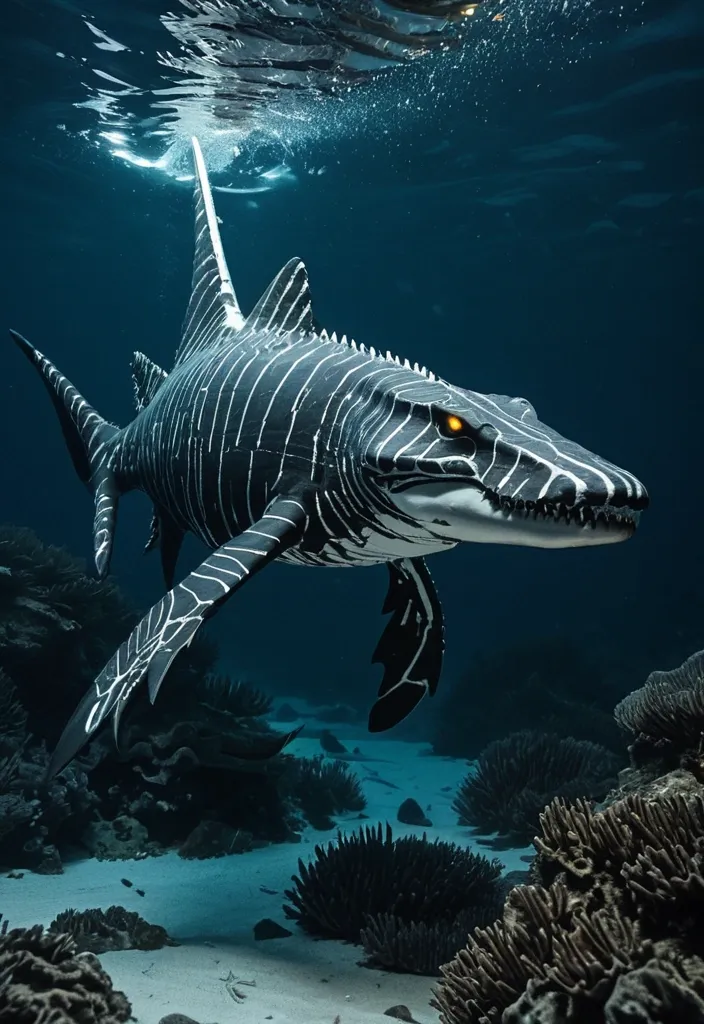
Megalosaurus Orca The Apex Hybrid of Oceanic Depths Physical Characteristics: Length: 40-60 feet Weight: 50-75 tons Lifespan: 100-135 years Coloration: Males: Jet black base with light gray tiger stripes Females: Slate gray base with white tiger stripes Bioluminescent red photophores arranged in tiger stripe patterns along the flanks and dorsal ridge , glowing vividly in abyssal darkness Body: Robust , muscular frame combining the thick , armored scales of saltwater crocodile with the hydrodynamic , flexible body of Mosasaurus Hoffmannii Fins: Large , rigid pectoral fins capable of tilting backward to reduce drag , inspired by the Black Marlin’s speed adaptations Limbs: Powerful flippers adapted for both swimming and short-distance land movement , similar to a leopard seal’s scooting style Jaw: Enormous , reinforced jaws with over 40 , 000+ PSI bite force , lined with long , razor-sharp canine teeth from Predator X and Megalodon genetics Skin: Coated with a thick mucus layer secreted like the Atlantic hagfish , providing parasite defense , moisture retention , and a slippery surface to evade predators and prey alike Respiratory system: Dual-function lungs and gills allow breathing in surface air and extracting oxygen from water , enabling survival from ocean surface to depths up to 9 , 800 feet Sensory: Passive listening capabilities from transient killer whale lineage enable near-silent hunting; bioluminescent photophores aid in communication and prey attraction in deep-sea darkness Abilities and Adaptations: Speed: Can burst up to 62-82 mph in water , rivaling the fastest sea creatures Salinity tolerance: Thrives in a wide range of water conditions , from freshwater estuaries to deep oceanic trenches , thanks to Mexican molly and saltwater crocodile genetics Regeneration: Limb and tissue regeneration inspired by axolotl traits , allowing recovery from injuries sustained during hunting or territorial battles Social structure: Lives in small , tight-knit family groups (1 male , 2 females) for efficient hunting and offspring rearing , reflecting transient killer whale social dynamics Reproduction: Live births occur at abyssal depths (~9 , 800 feet) , with offspring born adapted to extreme pressure and cold; males are streamlined for speed and power , while females are larger and more robust for nurturing and endurance Communication: Uses bioluminescent patterns and low-frequency vocalizations for mating displays , intimidation , and coordination during hunting Defense: Venomous spines inspired by the crown-of-thorns starfish line the dorsal ridge , delivering painful wounds to predators or rivals Hunting: Stealthy predator using passive listening to locate marine mammals and large prey; can leap and strike with explosive power , aided by shortfin mako shark agility and predator X bite force Backstory: Created in the secretive labs of Ceno Evail Crossgen Corporation , the Megalosaurus Orca was engineered as the ultimate marine apex predator , combining the might of prehistoric giants with the cunning and adaptability of modern ocean hunters. Designed to dominate a range of aquatic environments from sunlit coasts to the crushing abyss , these hybrids serve both as a scientific marvel and a living weapon for deep-sea exploration and control. The trio—one male and two females—are monitored closely , their social bonds and hunting strategies studied to unlock secrets of marine dominance and survival. Their ability to navigate and thrive across extreme depths , combined with their regenerative powers and venomous defenses , make them nearly invincible in their domain. ,

Megalosaurus Orca The Apex Hybrid of Oceanic Depths Physical Characteristics: Length: 40-60 feet Weight: 50-75 tons Lifespan: 100-135 years Coloration: Males: Jet black base with light gray tiger stripes Females: Slate gray base with white tiger stripes Bioluminescent red photophores arranged in tiger stripe patterns along the flanks and dorsal ridge , glowing vividly in abyssal darkness Body: Robust , muscular frame combining the thick , armored scales of saltwater crocodile with the hydrodynamic , flexible body of Mosasaurus Hoffmannii Fins: Large , rigid pectoral fins capable of tilting backward to reduce drag , inspired by the Black Marlin’s speed adaptations Limbs: Powerful flippers adapted for both swimming and short-distance land movement , similar to a leopard seal’s scooting style Jaw: Enormous , reinforced jaws with over 40 , 000+ PSI bite force , lined with long , razor-sharp canine teeth from Predator X and Megalodon genetics Skin: Coated with a thick mucus layer secreted like the Atlantic hagfish , providing parasite defense , moisture retention , and a slippery surface to evade predators and prey alike Respiratory system: Dual-function lungs and gills allow breathing in surface air and extracting oxygen from water , enabling survival from ocean surface to depths up to 9 , 800 feet Sensory: Passive listening capabilities from transient killer whale lineage enable near-silent hunting; bioluminescent photophores aid in communication and prey attraction in deep-sea darkness Abilities and Adaptations: Speed: Can burst up to 62-82 mph in water , rivaling the fastest sea creatures Salinity tolerance: Thrives in a wide range of water conditions , from freshwater estuaries to deep oceanic trenches , thanks to Mexican molly and saltwater crocodile genetics Regeneration: Limb and tissue regeneration inspired by axolotl traits , allowing recovery from injuries sustained during hunting or territorial battles Social structure: Lives in small , tight-knit family groups (1 male , 2 females) for efficient hunting and offspring rearing , reflecting transient killer whale social dynamics Reproduction: Live births occur at abyssal depths (~9 , 800 feet) , with offspring born adapted to extreme pressure and cold; males are streamlined for speed and power , while females are larger and more robust for nurturing and endurance Communication: Uses bioluminescent patterns and low-frequency vocalizations for mating displays , intimidation , and coordination during hunting Defense: Venomous spines inspired by the crown-of-thorns starfish line the dorsal ridge , delivering painful wounds to predators or rivals Hunting: Stealthy predator using passive listening to locate marine mammals and large prey; can leap and strike with explosive power , aided by shortfin mako shark agility and predator X bite force Backstory: Created in the secretive labs of Ceno Evail Crossgen Corporation , the Megalosaurus Orca was engineered as the ultimate marine apex predator , combining the might of prehistoric giants with the cunning and adaptability of modern ocean hunters. Designed to dominate a range of aquatic environments from sunlit coasts to the crushing abyss , these hybrids serve both as a scientific marvel and a living weapon for deep-sea exploration and control. The trio—one male and two females—are monitored closely , their social bonds and hunting strategies studied to unlock secrets of marine dominance and survival. Their ability to navigate and thrive across extreme depths , combined with their regenerative powers and venomous defenses , make them nearly invincible in their domain. ,
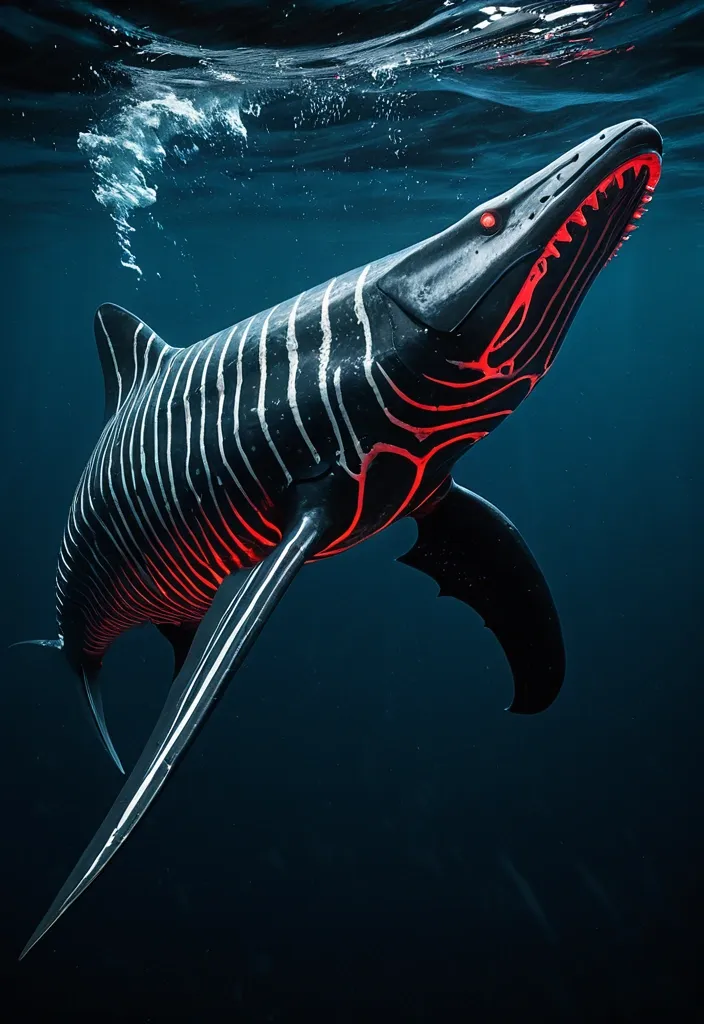
Physical Characteristics: Size & Weight: Between 40 to 60 feet in length , weighing 50 to 75 tons. Coloration: Males: Sleek black base with dark gray tiger stripes accented by subtle red bioluminescent highlights along the stripes , glowing faintly in deep ocean darkness. Females: Larger and more robust with black base and light gray tiger stripes , also featuring red bioluminescent patterns that pulse rhythmically. Body Structure: Hydrodynamic , muscular body combining the streamlined agility of the Shortfin Mako and Black Marlin with the robust power of Predator X and Megalodon. Rigid pectoral fins adapted from Black Marlin , capable of tilting back to reduce drag at high speeds. The tailend is a powerful fluke for propulsion , inspired by Mosasaurus Hoffmannii and Orca anatomy. Thick , overlapping bony scales similar to Arapaima , providing a durable armor that flexes with movement. Limbs: Powerful large flippers adapted for scooting or sliding on land , coated with mucus inspired by the Atlantic hagfish for moisture retention and defense. Capable of limited terrestrial movement , allowing brief excursions out of water. Head & Jaw: Massive jaws with over 40 , 000 PSI bite force , blending Predator X’s mighty jaw strength with the long canine teeth and powerful bite of the Leopard Seal. Flexible skull allowing swallowing of large prey whole. Respiration: Dual respiratory system with both functional lungs and gills , enabling survival from surface to abyssal depths (500 to 9 , 800 feet). Bioluminescence: Red bioluminescent photophores patterned in tiger stripes , used for communication , intimidation , mating displays , and luring prey in the dark ocean depths. Abilities & Traits: Speed & Agility: Capable of bursts up to 82 mph , rivaling the fastest sea creatures like the Black Marlin. Agile hunter using stealth and passive listening , mimicking Transient Killer Whale hunting strategies. Social Structure: Small family groups of three (one male , two females) designed for efficient reproduction and hunting. Males are more streamlined and shorter , optimized for speed and power; females are larger , robust , and agile for endurance and nurturing. Regeneration: Remarkable limb regeneration inspired by axolotl and Crown-of-Thorns starfish , able to regrow lost fins , limbs , and even parts of internal organs. Defense: Venomous spines derived from Crown-of-Thorns starfish line its dorsal ridge , delivering painful venomous wounds to attackers. Mucus coating for defense and moisture retention , also making it slippery and difficult to grasp. Healing: A blubber-like layer similar to dolphins provides insulation , buoyancy , and antimicrobial properties that accelerate healing of wounds. Communication: Uses low-frequency growls , barks , and hisses inspired by saltwater crocodile sounds , combined with bioluminescent signals and stealth vocalizations for hunting. Reproduction: Live births occur at extreme depths (up to 9 , 800 feet) , with offspring adapted to survive in crushing pressures and cold temperatures. Backstory: Created by the Ceno Evail Crossgen Corporation , the Megalosaurus Orca was engineered to dominate marine ecosystems and serve as a living testament to the pinnacle of hybrid dinosaur biotechnology. Designed to combine the raw power of ancient sea predators like Predator X and Megalodon with the intelligence , social hunting , and adaptability of modern marine mammals and fish , this hybrid thrives in the dark , cold depths of the ocean where few predators dare to venture. Their unique physiology allows them to traverse both deep ocean trenches and brief terrestrial environments , making them versatile apex predators. The three known individuals—one male and two females—form a tight-knit family unit , hunting elusive marine mammals and large fish with stealth and precision. Their bioluminescent stripes not only intimidate rivals but also help coordinate complex hunting maneuvers in pitch-black waters. With a lifespan of 100 to 135 years , they are long-lived titans of the sea , their legacy intertwined with the future of marine genetic engineering and the mysteries of oceanic evolution. ,
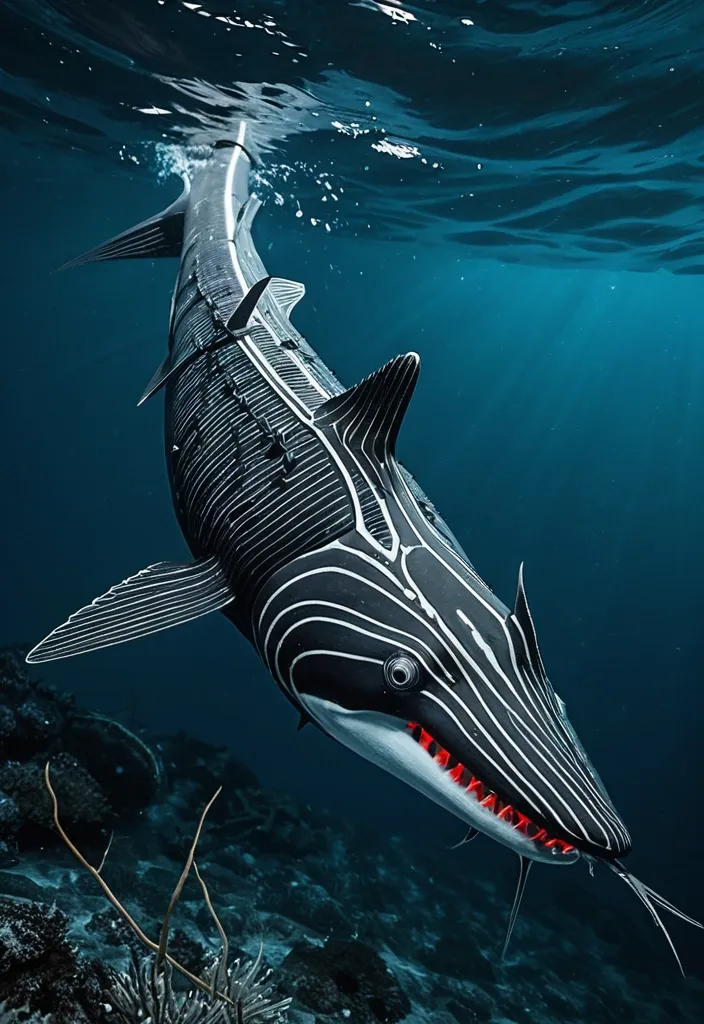
Physical Characteristics: Size & Weight: Between 40 to 60 feet in length , weighing 50 to 75 tons. Coloration: Males: Sleek black base with dark gray tiger stripes accented by subtle red bioluminescent highlights along the stripes , glowing faintly in deep ocean darkness. Body Structure: Hydrodynamic , muscular body combining the streamlined agility of the Shortfin Mako and Black Marlin with the robust power of Predator X and Megalodon. Rigid pectoral fins adapted from Black Marlin , capable of tilting back to reduce drag at high speeds. The tailend is a powerful fluke for propulsion , inspired by Mosasaurus Hoffmannii and Orca anatomy. Thick , overlapping bony scales similar to Arapaima , providing a durable armor that flexes with movement. Limbs: Powerful large flippers adapted for scooting or sliding on land , coated with mucus inspired by the Atlantic hagfish for moisture retention and defense. Capable of limited terrestrial movement , allowing brief excursions out of water. Head & Jaw: Massive jaws with over 40 , 000 PSI bite force , blending Predator X’s mighty jaw strength with the long canine teeth and powerful bite of the Leopard Seal. Flexible skull allowing swallowing of large prey whole. Respiration: Dual respiratory system with both functional lungs and gills , enabling survival from surface to abyssal depths (500 to 9 , 800 feet). Bioluminescence: Red bioluminescent photophores patterned in tiger stripes , used for communication , mating displays , and luring prey in the dark ocean depths. Abilities & Traits: Speed & Agility: Capable of bursts up to 82 mph , rivaling the fastest sea creatures like the Black Marlin. Agile hunter using stealth and passive listening , mimicking Transient Killer Whale hunting strategies. Social Structure: Small family groups of three (one male , two females) designed for efficient reproduction and hunting. Males are more streamlined and shorter , optimized for speed and power; females are larger , robust , and agile for endurance and nurturing. Regeneration: Remarkable limb regeneration inspired by axolotl and Crown-of-Thorns starfish , able to regrow lost fins , limbs , and even parts of internal organs. Defense: Venomous spines derived from Crown-of-Thorns starfish line its dorsal ridge , delivering painful venomous wounds to attackers. Mucus coating for defense and moisture retention , also making it slippery and difficult to grasp. Healing: A blubber-like layer similar to dolphins provides insulation , buoyancy , and antimicrobial properties that accelerate healing of wounds. Communication: Uses low-frequency growls , barks , and hisses inspired by saltwater crocodile sounds , combined with bioluminescent signals and stealth vocalizations for hunting. Reproduction: Live births occur at extreme depths (up to 9 , 800 feet) , with offspring adapted to survive in crushing pressures and cold temperatures. ,
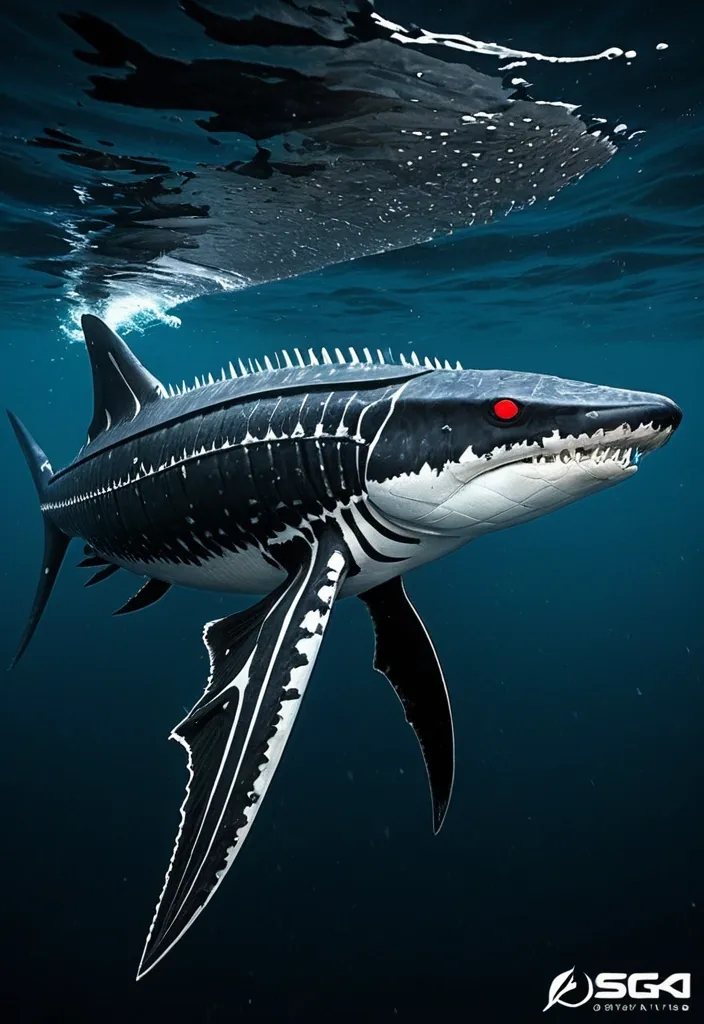
Physical Characteristics: Size & Weight: Between 40 to 60 feet in length , weighing 50 to 75 tons. Coloration: Males: Sleek black base with dark gray tiger stripes accented by subtle red bioluminescent highlights along the stripes , glowing faintly in deep ocean darkness. Body Structure: Hydrodynamic , muscular body combining the streamlined agility of the Shortfin Mako and Black Marlin with the robust power of Predator X and Megalodon. Rigid pectoral fins adapted from Black Marlin , capable of tilting back to reduce drag at high speeds. The tailend is a powerful fluke for propulsion , inspired by Mosasaurus Hoffmannii and Orca anatomy. Thick , overlapping bony scales similar to Arapaima , providing a durable armor that flexes with movement. Limbs: Powerful large flippers adapted for scooting or sliding on land , coated with mucus inspired by the Atlantic hagfish for moisture retention and defense. Capable of limited terrestrial movement , allowing brief excursions out of water. Head & Jaw: Massive jaws with over 40 , 000 PSI bite force , blending Predator X’s mighty jaw strength with the long canine teeth and powerful bite of the Leopard Seal. Flexible skull allowing swallowing of large prey whole. Respiration: Dual respiratory system with both functional lungs and gills , enabling survival from surface to abyssal depths (500 to 9 , 800 feet). Bioluminescence: Red bioluminescent photophores patterned in tiger stripes , used for communication , mating displays , and luring prey in the dark ocean depths. Abilities & Traits: Speed & Agility: Capable of bursts up to 82 mph , rivaling the fastest sea creatures like the Black Marlin. Agile hunter using stealth and passive listening , mimicking Transient Killer Whale hunting strategies. Social Structure: Small family groups of three (one male , two females) designed for efficient reproduction and hunting. Males are more streamlined and shorter , optimized for speed and power; females are larger , robust , and agile for endurance and nurturing. Regeneration: Remarkable limb regeneration inspired by axolotl and Crown-of-Thorns starfish , able to regrow lost fins , limbs , and even parts of internal organs. Defense: Venomous spines derived from Crown-of-Thorns starfish line its dorsal ridge , delivering painful venomous wounds to attackers. Mucus coating for defense and moisture retention , also making it slippery and difficult to grasp. Healing: A blubber-like layer similar to dolphins provides insulation , buoyancy , and antimicrobial properties that accelerate healing of wounds. Communication: Uses low-frequency growls , barks , and hisses inspired by saltwater crocodile sounds , combined with bioluminescent signals and stealth vocalizations for hunting. Reproduction: Live births occur at extreme depths (up to 9 , 800 feet) , with offspring adapted to survive in crushing pressures and cold temperatures. ,
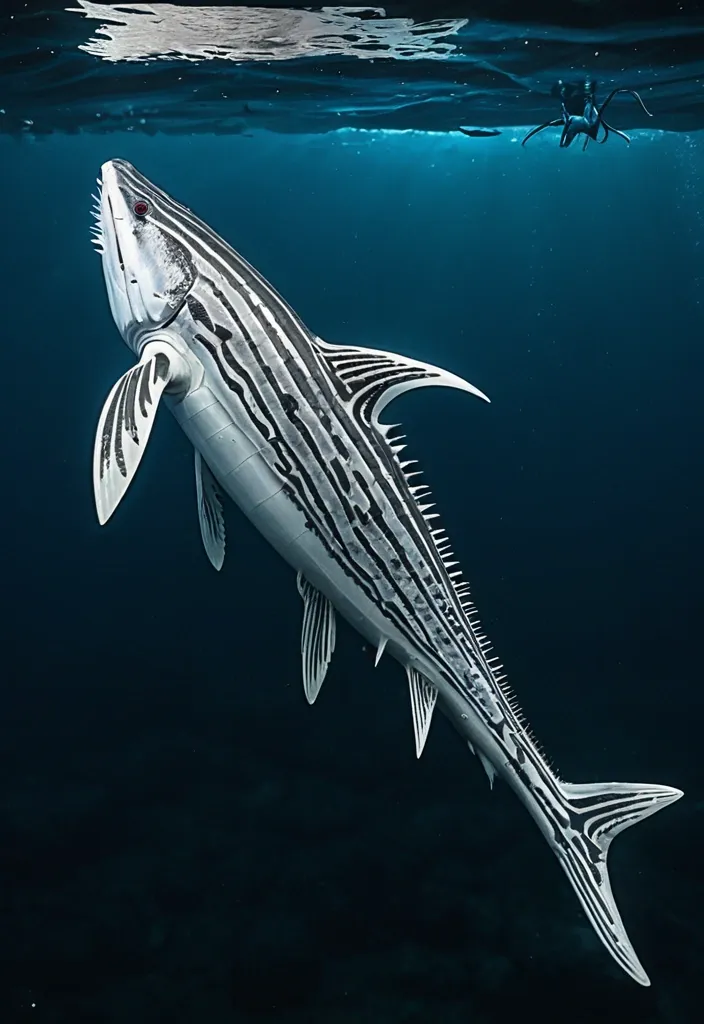
Physical Characteristics: Size & Weight: Between 40 to 60 feet in length , weighing 50 to 75 tons. Coloration: Females: Larger and more robust with black base and light gray tiger stripes , also featuring red bioluminescent patterns that pulse rhythmically. Body Structure: Hydrodynamic , muscular body combining the streamlined agility of the Shortfin Mako and Black Marlin with the robust power of Predator X and Megalodon. Rigid pectoral fins adapted from Black Marlin , capable of tilting back to reduce drag at high speeds. The tailend is a powerful fluke for propulsion , inspired by Mosasaurus Hoffmannii and Orca anatomy. Thick , overlapping bony scales similar to Arapaima , providing a durable armor that flexes with movement. Limbs: Powerful large flippers adapted for scooting or sliding on land , coated with mucus inspired by the Atlantic hagfish for moisture retention and defense. Capable of limited terrestrial movement , allowing brief excursions out of water. Head & Jaw: Massive jaws with over 40 , 000 PSI bite force , blending Predator X’s mighty jaw strength with the long canine teeth and powerful bite of the Leopard Seal. Flexible skull allowing swallowing of large prey whole. Respiration: Dual respiratory system with both functional lungs and gills , enabling survival from surface to abyssal depths (500 to 9 , 800 feet). Bioluminescence: Red bioluminescent photophores patterned in tiger stripes , used for communication , mating displays , and luring prey in the dark ocean depths. Abilities & Traits: Speed & Agility: Capable of bursts up to 82 mph , rivaling the fastest sea creatures like the Black Marlin. Agile hunter using stealth and passive listening , mimicking Transient Killer Whale hunting strategies. Social Structure: Small family groups of three (one male , two females) designed for efficient reproduction and hunting. Males are more streamlined and shorter , optimized for speed and power; females are larger , robust , and agile for endurance and nurturing. Regeneration: Remarkable limb regeneration inspired by axolotl and Crown-of-Thorns starfish , able to regrow lost fins , limbs , and even parts of internal organs. Defense: Venomous spines derived from Crown-of-Thorns starfish line its dorsal ridge , delivering painful venomous wounds to attackers. Mucus coating for defense and moisture retention , also making it slippery and difficult to grasp. Healing: A blubber-like layer similar to dolphins provides insulation , buoyancy , and antimicrobial properties that accelerate healing of wounds. Communication: Uses low-frequency growls , barks , and hisses inspired by saltwater crocodile sounds , combined with bioluminescent signals and stealth vocalizations for hunting. Reproduction: Live births occur at extreme depths (up to 9 , 800 feet) , with offspring adapted to survive in crushing pressures and cold temperatures. ,
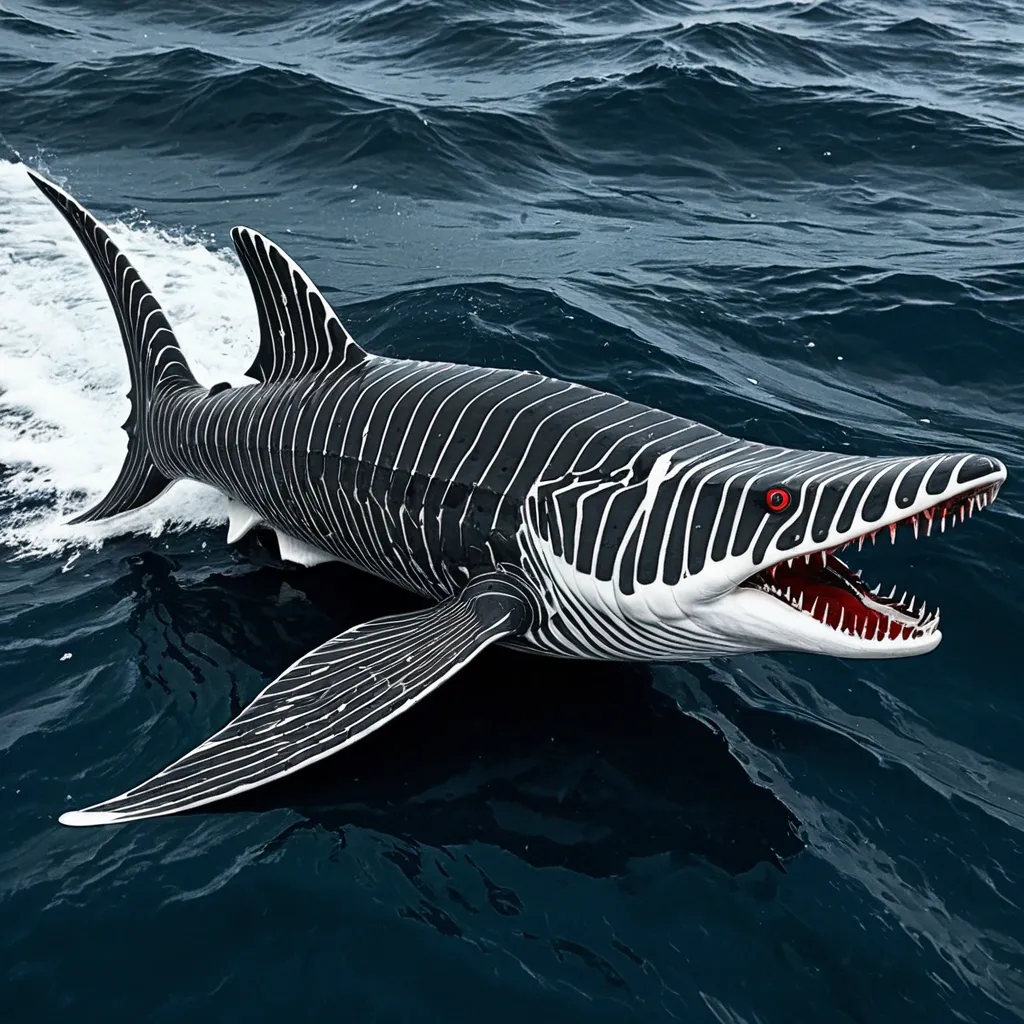
Physical Characteristics: Size & Weight: Between 40 to 60 feet in length , weighing 50 to 75 tons. Coloration: Females: Larger and more robust with black base and light gray tiger stripes , also featuring red bioluminescent patterns that pulse rhythmically. Body Structure: Hydrodynamic , muscular body combining the streamlined agility of the Shortfin Mako and Black Marlin with the robust power of Predator X and Megalodon. Rigid pectoral fins adapted from Black Marlin , capable of tilting back to reduce drag at high speeds. The tailend is a powerful fluke for propulsion , inspired by Mosasaurus Hoffmannii and Orca anatomy. Thick , overlapping bony scales similar to Arapaima , providing a durable armor that flexes with movement. Limbs: Powerful large flippers adapted for scooting or sliding on land , coated with mucus inspired by the Atlantic hagfish for moisture retention and defense. Capable of limited terrestrial movement , allowing brief excursions out of water. Head & Jaw: Massive jaws with over 40 , 000 PSI bite force , blending Predator X’s mighty jaw strength with the long canine teeth and powerful bite of the Leopard Seal. Flexible skull allowing swallowing of large prey whole. Respiration: Dual respiratory system with both functional lungs and gills , enabling survival from surface to abyssal depths (500 to 9 , 800 feet). Bioluminescence: Red bioluminescent photophores patterned in tiger stripes , used for communication , mating displays , and luring prey in the dark ocean depths. Abilities & Traits: Speed & Agility: Capable of bursts up to 82 mph , rivaling the fastest sea creatures like the Black Marlin. Agile hunter using stealth and passive listening , mimicking Transient Killer Whale hunting strategies. Social Structure: Small family groups of three (one male , two females) designed for efficient reproduction and hunting. Males are more streamlined and shorter , optimized for speed and power; females are larger , robust , and agile for endurance and nurturing. Regeneration: Remarkable limb regeneration inspired by axolotl and Crown-of-Thorns starfish , able to regrow lost fins , limbs , and even parts of internal organs. Defense: Venomous spines derived from Crown-of-Thorns starfish line its dorsal ridge , delivering painful venomous wounds to attackers. Mucus coating for defense and moisture retention , also making it slippery and difficult to grasp. Healing: A blubber-like layer similar to dolphins provides insulation , buoyancy , and antimicrobial properties that accelerate healing of wounds. Communication: Uses low-frequency growls , barks , and hisses inspired by saltwater crocodile sounds , combined with bioluminescent signals and stealth vocalizations for hunting. Reproduction: Live births occur at extreme depths (up to 9 , 800 feet) , with offspring adapted to survive in crushing pressures and cold temperatures. ,
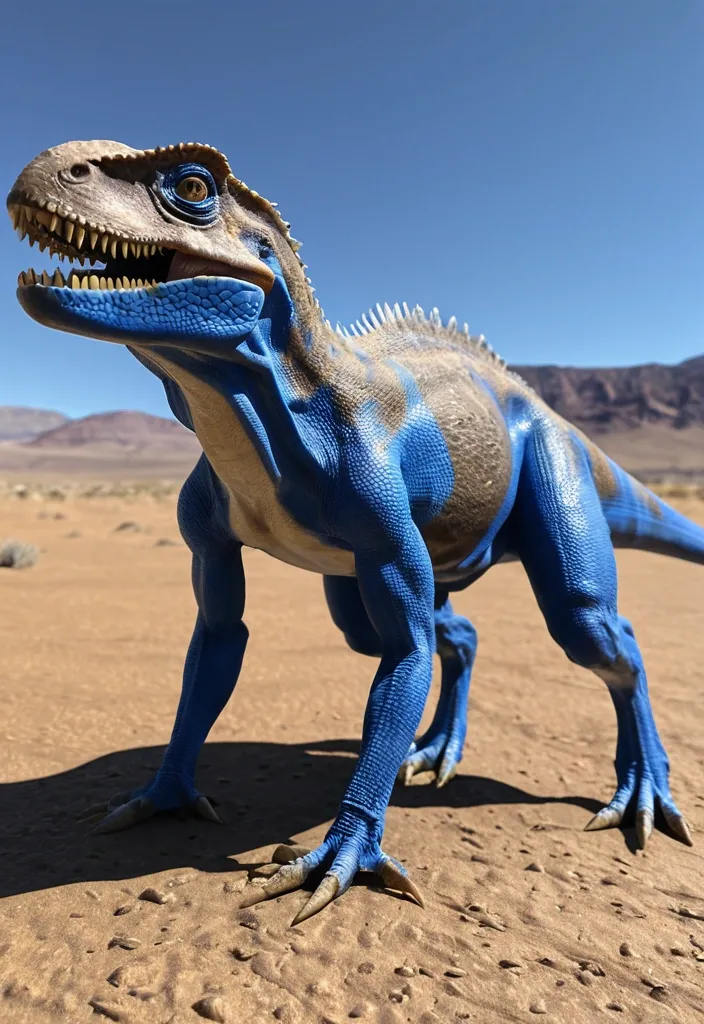
The hybrid was created by modifying the genome of a Tyrannosaurus rex , with the DNA of three other theropod species that were Utahraptor , Saurophaganax , and Giganotosaurus. Also the DNA of Quadrupes like Triceratops , Scelidosaurus , Gigantopithecus. DNA of modern animals such as Greater blue-ringed octopus , Inland Taipan , Northern Short-tailed Shrew , Komodo Dragon , Opossum , Mongoose , Whiptail Lizard , Cuttlefish , and Tardigrades. The genome of Tyrannosaurus rex , Utahraptor , Saurophaganax , and Giganotosaurus was used as the base genome for the hybrid. The shape of the headcrest is from the Triceratops. Utahraptor DNA was added for high levels of intelligence and the ability to make plans , decisions and pack hunting. Gigantopithecus DNA added for Knuckle-walking. Triceratops , and Scelidosaurus armor added a biological form of armor that absorbed most of the incoming attacks. Northern short-tailed shrew iron teeth , the Inland taipan's retractable fangs and the Komodo Dragon serrated teeth genome was used to form the teething of the hybrid. Saurophaganax and Gigantopithecus DNA added the presence of long strong arms with slashing hook claws and the use of tools. Cuttlefish genes were intended to help the hybrid withstand an accelerated growth , but it also added chromatophore cells in the skin so it could change the shape , color , and texture of its skin like a cuttlefish. Opossum , Mongoose and Tardigrades DNA was added for the hybrid to be more resistant to climate changes , harmful toxins or bacterial infections , while tardigrades also added survival of extreme conditions such as exposure to extreme temperatures , extreme pressures , air deprivation , radiation , dehydration , and starvation. Northern short-tailed shrew , the Inland Taipan , Greater blue-ringed octopus and the Komodo Dragon's DNA also added special cavities and glands in the skull that gave her infrared vision , and highly toxic saliva. Said DNA also gave her the ability to open her mandibles and jaws as wide as a snake , specifically at around 90 degrees.Lastly , DNA from a whiptail lizard was added for reproduction purposes. ,
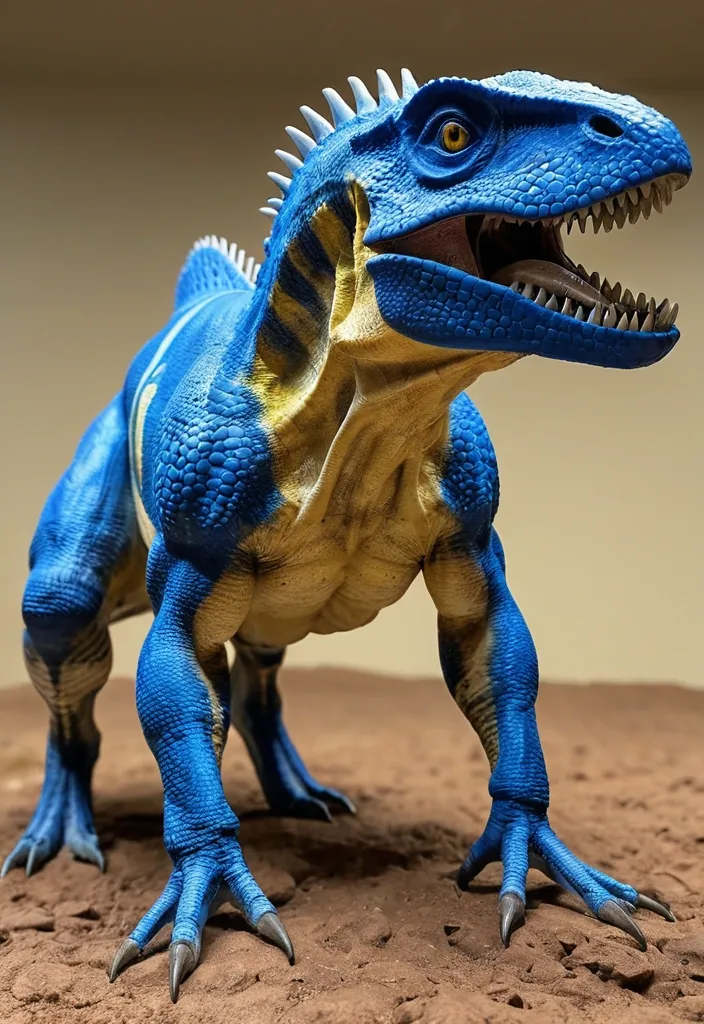
The hybrid was created by modifying the genome of a Tyrannosaurus rex , with the DNA of three other theropod species that were Utahraptor , Saurophaganax , and Giganotosaurus. Also the DNA of Quadrupes like Triceratops , Scelidosaurus , Gigantopithecus. DNA of modern animals such as Greater blue-ringed octopus , Inland Taipan , Northern Short-tailed Shrew , Komodo Dragon , Opossum , Mongoose , Whiptail Lizard , Cuttlefish , and Tardigrades. The genome of Tyrannosaurus rex , Utahraptor , Saurophaganax , and Giganotosaurus was used as the base genome for the hybrid. The shape of the headcrest is from the Triceratops. Utahraptor DNA was added for high levels of intelligence and the ability to make plans , decisions and pack hunting. Gigantopithecus DNA added for Knuckle-walking. Triceratops , and Scelidosaurus armor added a biological form of armor that absorbed most of the incoming attacks. Northern short-tailed shrew iron teeth , the Inland taipan's retractable fangs and the Komodo Dragon serrated teeth genome was used to form the teething of the hybrid. Saurophaganax and Gigantopithecus DNA added the presence of long strong arms with slashing hook claws and the use of tools. Cuttlefish genes were intended to help the hybrid withstand an accelerated growth , but it also added chromatophore cells in the skin so it could change the shape , color , and texture of its skin like a cuttlefish. Opossum , Mongoose and Tardigrades DNA was added for the hybrid to be more resistant to climate changes , harmful toxins or bacterial infections , while tardigrades also added survival of extreme conditions such as exposure to extreme temperatures , extreme pressures , air deprivation , radiation , dehydration , and starvation. Northern short-tailed shrew , the Inland Taipan , Greater blue-ringed octopus and the Komodo Dragon's DNA also added special cavities and glands in the skull that gave her infrared vision , and highly toxic saliva. Said DNA also gave her the ability to open her mandibles and jaws as wide as a snake , specifically at around 90 degrees.Lastly , DNA from a whiptail lizard was added for reproduction purposes. ,
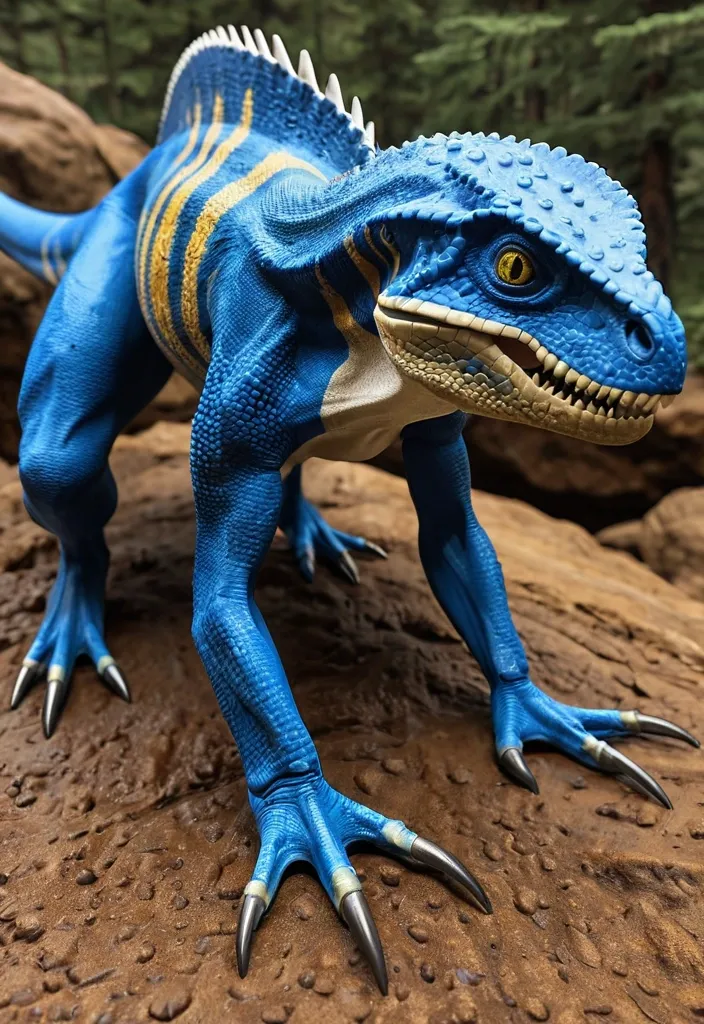
The hybrid was created by modifying the genome of a Tyrannosaurus rex , with the DNA of three other theropod species that were Utahraptor , Saurophaganax , and Giganotosaurus. Also the DNA of Quadrupes like Triceratops , Scelidosaurus , Gigantopithecus. DNA of modern animals such as Greater blue-ringed octopus , Inland Taipan , Northern Short-tailed Shrew , Komodo Dragon , Opossum , Mongoose , Whiptail Lizard , Cuttlefish , and Tardigrades. The genome of Tyrannosaurus rex , Utahraptor , Saurophaganax , and Giganotosaurus was used as the base genome for the hybrid. The shape of the headcrest is from the Triceratops. Utahraptor DNA was added for high levels of intelligence and the ability to make plans , decisions and pack hunting. Gigantopithecus DNA added for Knuckle-walking. Triceratops , and Scelidosaurus armor added a biological form of armor that absorbed most of the incoming attacks. Northern short-tailed shrew iron teeth , the Inland taipan's retractable fangs and the Komodo Dragon serrated teeth genome was used to form the teething of the hybrid. Saurophaganax and Gigantopithecus DNA added the presence of long strong arms with slashing hook claws and the use of tools. Cuttlefish genes were intended to help the hybrid withstand an accelerated growth , but it also added chromatophore cells in the skin so it could change the shape , color , and texture of its skin like a cuttlefish. Opossum , Mongoose and Tardigrades DNA was added for the hybrid to be more resistant to climate changes , harmful toxins or bacterial infections , while tardigrades also added survival of extreme conditions such as exposure to extreme temperatures , extreme pressures , air deprivation , radiation , dehydration , and starvation. Northern short-tailed shrew , the Inland Taipan , Greater blue-ringed octopus and the Komodo Dragon's DNA also added special cavities and glands in the skull that gave her infrared vision , and highly toxic saliva. Said DNA also gave her the ability to open her mandibles and jaws as wide as a snake , specifically at around 90 degrees.Lastly , DNA from a whiptail lizard was added for reproduction purposes. ,
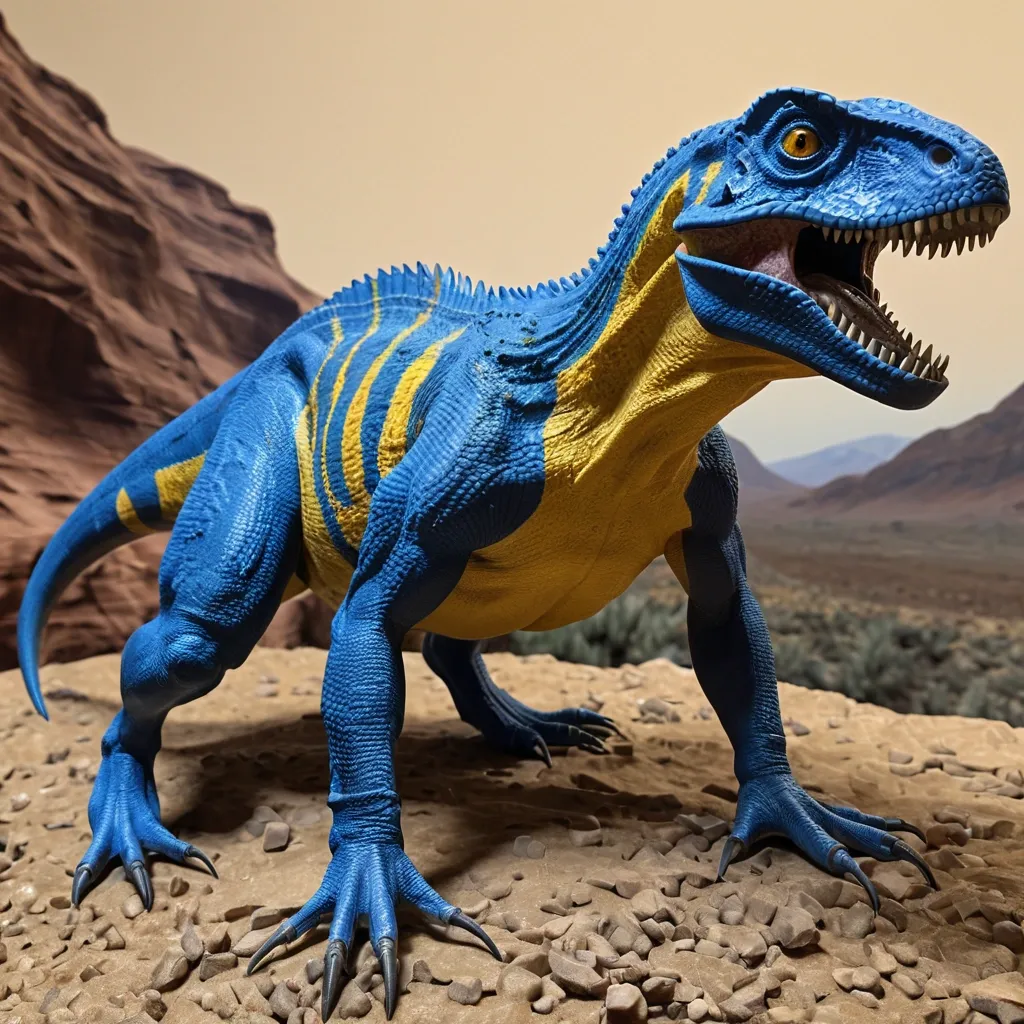
The hybrid was created by modifying the genome of a Tyrannosaurus rex , with the DNA of three other theropod species that were Utahraptor , Saurophaganax , and Giganotosaurus. Also the DNA of Quadrupes like Triceratops , Scelidosaurus , Gigantopithecus. DNA of modern animals such as Greater blue-ringed octopus , Inland Taipan , Northern Short-tailed Shrew , Komodo Dragon , Opossum , Mongoose , Whiptail Lizard , Cuttlefish , and Tardigrades. The genome of Tyrannosaurus rex , Utahraptor , Saurophaganax , and Giganotosaurus was used as the base genome for the hybrid. The shape of the headcrest is from the Triceratops. Utahraptor DNA was added for high levels of intelligence and the ability to make plans , decisions and pack hunting. Gigantopithecus DNA added for Knuckle-walking. Triceratops , and Scelidosaurus armor added a biological form of armor that absorbed most of the incoming attacks. Northern short-tailed shrew iron teeth , the Inland taipan's retractable fangs and the Komodo Dragon serrated teeth genome was used to form the teething of the hybrid. Saurophaganax and Gigantopithecus DNA added the presence of long strong arms with slashing hook claws and the use of tools. Cuttlefish genes were intended to help the hybrid withstand an accelerated growth , but it also added chromatophore cells in the skin so it could change the shape , color , and texture of its skin like a cuttlefish. Opossum , Mongoose and Tardigrades DNA was added for the hybrid to be more resistant to climate changes , harmful toxins or bacterial infections , while tardigrades also added survival of extreme conditions such as exposure to extreme temperatures , extreme pressures , air deprivation , radiation , dehydration , and starvation. Northern short-tailed shrew , the Inland Taipan , Greater blue-ringed octopus and the Komodo Dragon's DNA also added special cavities and glands in the skull that gave her infrared vision , and highly toxic saliva. Said DNA also gave her the ability to open her mandibles and jaws as wide as a snake , specifically at around 90 degrees.Lastly , DNA from a whiptail lizard was added for reproduction purposes. ,
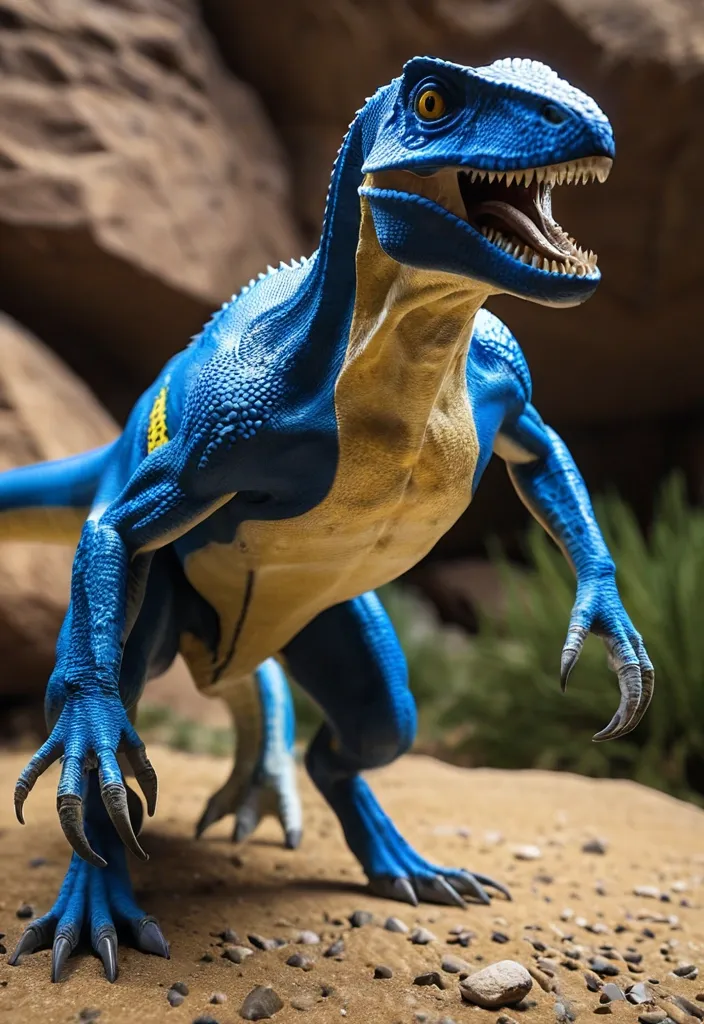
The hybrid was created by modifying the genome of a Tyrannosaurus rex , with the DNA of three other theropod species that were Utahraptor , Saurophaganax , and Giganotosaurus. Also the DNA of Quadrupes like Triceratops , Scelidosaurus , Gigantopithecus. DNA of modern animals such as Greater blue-ringed octopus , Inland Taipan , Northern Short-tailed Shrew , Komodo Dragon , Opossum , Mongoose , Whiptail Lizard , Cuttlefish , and Tardigrades. The genome of Tyrannosaurus rex , Utahraptor , Saurophaganax , and Giganotosaurus was used as the base genome for the hybrid. The shape of the headcrest is from the Triceratops. Utahraptor DNA was added for high levels of intelligence and the ability to make plans , decisions and pack hunting. Gigantopithecus DNA added for Knuckle-walking. Triceratops , and Scelidosaurus armor added a biological form of armor that absorbed most of the incoming attacks. Northern short-tailed shrew iron teeth , the Inland taipan's retractable fangs and the Komodo Dragon serrated teeth genome was used to form the teething of the hybrid. Saurophaganax and Gigantopithecus DNA added the presence of long strong arms with slashing hook claws and the use of tools. Cuttlefish genes were intended to help the hybrid withstand an accelerated growth , but it also added chromatophore cells in the skin so it could change the shape , color , and texture of its skin like a cuttlefish. Opossum , Mongoose and Tardigrades DNA was added for the hybrid to be more resistant to climate changes , harmful toxins or bacterial infections , while tardigrades also added survival of extreme conditions such as exposure to extreme temperatures , extreme pressures , air deprivation , radiation , dehydration , and starvation. Northern short-tailed shrew , the Inland Taipan , Greater blue-ringed octopus and the Komodo Dragon's DNA also added special cavities and glands in the skull that gave her infrared vision , and highly toxic saliva. Said DNA also gave her the ability to open her mandibles and jaws as wide as a snake , specifically at around 90 degrees.Lastly , DNA from a whiptail lizard was added for reproduction purposes. ,
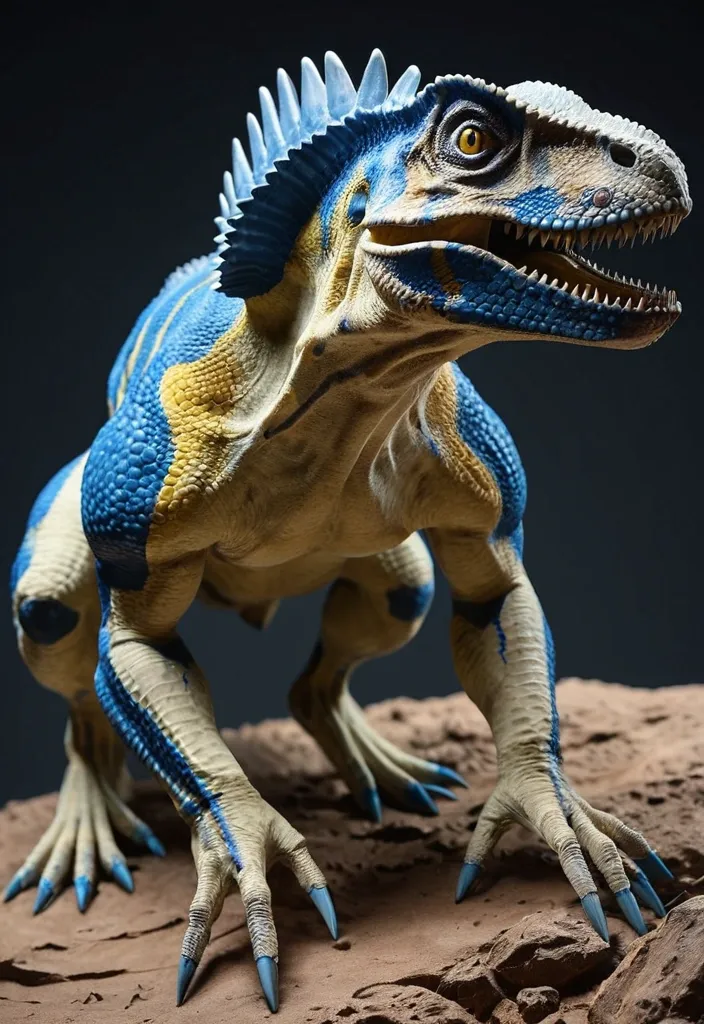
The hybrid was created by modifying the genome of a Tyrannosaurus rex , with the DNA of three other theropod species that were Utahraptor , Saurophaganax , and Giganotosaurus. Also the DNA of Quadrupes like Triceratops , and Scelidosaurus. DNA of modern animals such as Greater blue-ringed octopus , Inland Taipan , Northern Short-tailed Shrew , Komodo Dragon , Opossum , Mongoose , Gigantopithecus , Whiptail Lizard , Cuttlefish , and Tardigrades. The genome of Tyrannosaurus rex , Triceratops and Giganotosaurus was used as the base genome for the hybrid. Including the shape of the head in some parts from Giganotosaurus and Triceratops. Utahraptor DNA was added for high levels of intelligence and the ability to make plans , decisions and pack hunting. Reduced hind legs and Ape DNA added Knuckle-walking Quadruped. Triceratops , and Scelidosaurus were added to act as a biological form of armor that absorbed most of the incoming attacks. Northern short-tailed shrew , the Inland taipan's retractable fangs and the Komodo Dragon DNA was used to form the teeth of the Indominus that were used to tear through the flesh and armor of opponents. Saurophaganax and Gigantopithecus DNA added the presence of long strong arms with slashing hook claws and the use of tools. A swipe of the hybrid's claws would take down bigger opponents. While using tools for smaller elusive prey. Cuttlefish genes were intended to help the Venenosus withstand an accelerated growth , but it also added chromatophore cells in the skin so it could change the shape , color , and texture of its skin like a cuttlefish. Opossum , Mongoose and Tardigrades DNA was added for the Venenosus to be more resistant to climate changes , harmful toxins or bacterial infections , while tardigrades also added survival of extreme conditions such as exposure to extreme temperatures , extreme pressures , air deprivation , radiation , dehydration , and starvation. They have several defense mechanisms , including: A metabolic rate that gets as low as 0.01 percent of the normal rate. Organs protected by a sugary gel called trehalose. A protein that shields their DNA from radiation harm. Synthesis of cryoprotectant in chilly temperatures to prevent the development of ice crystals.Northern short-tailed shrew , the Inland Taipan , Greater blue-ringed octopus and the Komodo Dragon's DNA also added special cavities and glands in the skull that gave her infrared vision , and highly toxic saliva. Said DNA also gave her the ability to open her mandibles and jaws as wide as a snake , specifically at around 90 degrees.Lastly , DNA from a whiptail lizard was added for reproduction purposes. ,
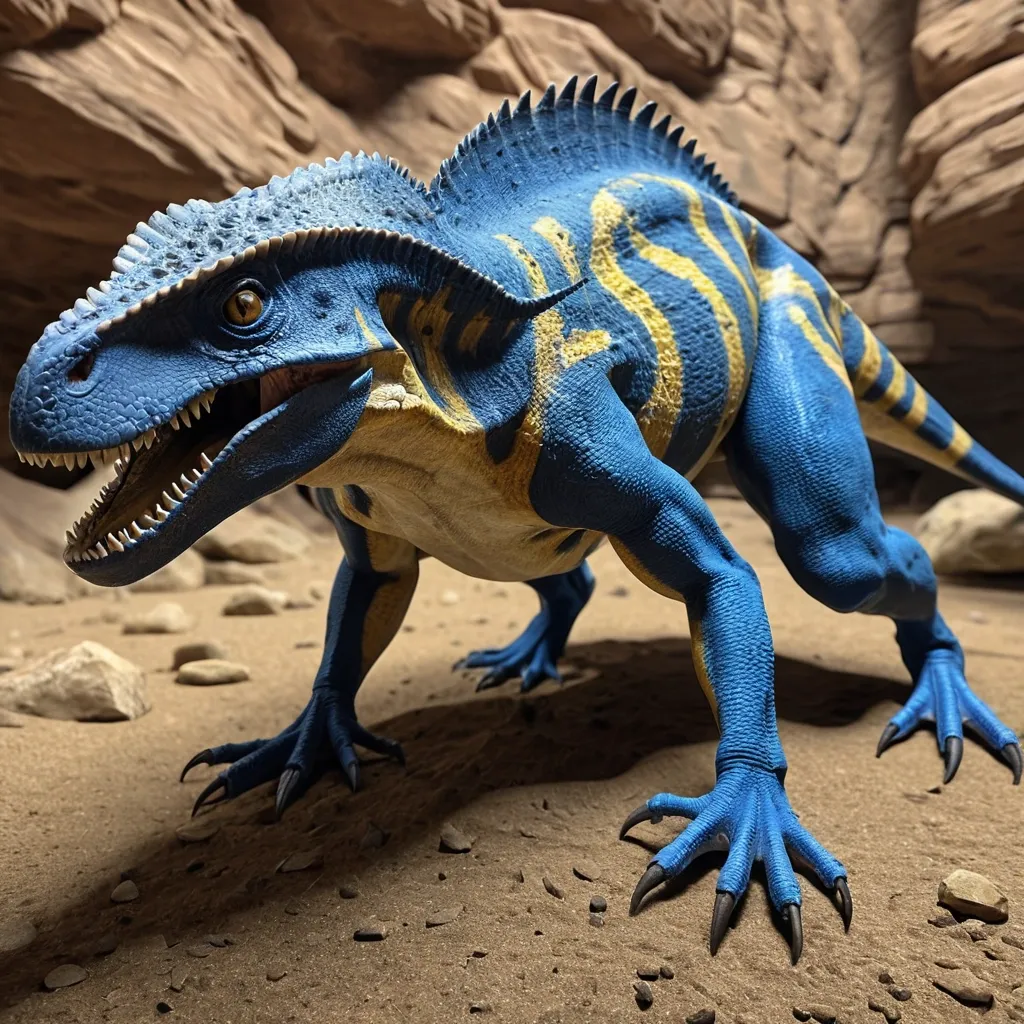
The hybrid was created by modifying the genome of a Tyrannosaurus rex , with the DNA of three other theropod species that were Utahraptor , Saurophaganax , and Giganotosaurus. Also the DNA of Quadrupes like Triceratops , and Scelidosaurus. DNA of modern animals such as Greater blue-ringed octopus , Inland Taipan , Northern Short-tailed Shrew , Komodo Dragon , Opossum , Mongoose , Gigantopithecus , Whiptail Lizard , Cuttlefish , and Tardigrades. The genome of Tyrannosaurus rex , Triceratops and Giganotosaurus was used as the base genome for the hybrid. Including the shape of the head in some parts from Giganotosaurus and Triceratops. Utahraptor DNA was added for high levels of intelligence and the ability to make plans , decisions and pack hunting. Reduced hind legs and Ape DNA added Knuckle-walking Quadruped. Triceratops , and Scelidosaurus were added to act as a biological form of armor that absorbed most of the incoming attacks. Northern short-tailed shrew , the Inland taipan's retractable fangs and the Komodo Dragon DNA was used to form the teeth of the Indominus that were used to tear through the flesh and armor of opponents. Saurophaganax and Gigantopithecus DNA added the presence of long strong arms with slashing hook claws and the use of tools. A swipe of the hybrid's claws would take down bigger opponents. While using tools for smaller elusive prey. Cuttlefish genes were intended to help the Venenosus withstand an accelerated growth , but it also added chromatophore cells in the skin so it could change the shape , color , and texture of its skin like a cuttlefish. Opossum , Mongoose and Tardigrades DNA was added for the Venenosus to be more resistant to climate changes , harmful toxins or bacterial infections , while tardigrades also added survival of extreme conditions such as exposure to extreme temperatures , extreme pressures , air deprivation , radiation , dehydration , and starvation. They have several defense mechanisms , including: A metabolic rate that gets as low as 0.01 percent of the normal rate. Organs protected by a sugary gel called trehalose. A protein that shields their DNA from radiation harm. Synthesis of cryoprotectant in chilly temperatures to prevent the development of ice crystals.Northern short-tailed shrew , the Inland Taipan , Greater blue-ringed octopus and the Komodo Dragon's DNA also added special cavities and glands in the skull that gave her infrared vision , and highly toxic saliva. Said DNA also gave her the ability to open her mandibles and jaws as wide as a snake , specifically at around 90 degrees.Lastly , DNA from a whiptail lizard was added for reproduction purposes. ,
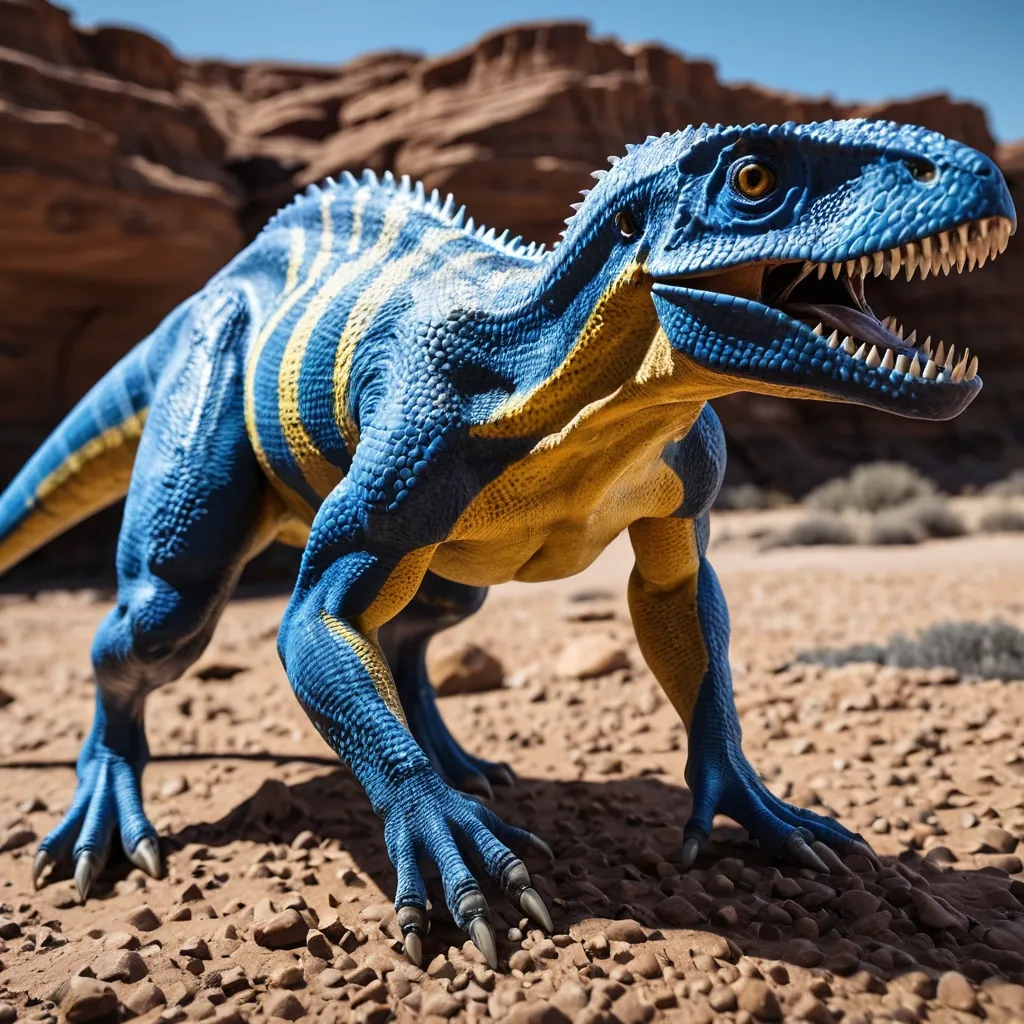
The hybrid was created by modifying the genome of a Tyrannosaurus rex , with the DNA of three other theropod species that were Utahraptor , Saurophaganax , and Giganotosaurus. Also the DNA of Quadrupes like Triceratops , and Scelidosaurus. DNA of modern animals such as Greater blue-ringed octopus , Inland Taipan , Northern Short-tailed Shrew , Komodo Dragon , Opossum , Mongoose , Gigantopithecus , Whiptail Lizard , Cuttlefish , and Tardigrades. The genome of Tyrannosaurus rex , Triceratops and Giganotosaurus was used as the base genome for the hybrid. Including the shape of the head in some parts from Giganotosaurus and Triceratops. Utahraptor DNA was added for high levels of intelligence and the ability to make plans , decisions and pack hunting. Reduced hind legs and Ape DNA added Knuckle-walking Quadruped. Triceratops , and Scelidosaurus were added to act as a biological form of armor that absorbed most of the incoming attacks. Northern short-tailed shrew , the Inland taipan's retractable fangs and the Komodo Dragon DNA was used to form the teeth of the Indominus that were used to tear through the flesh and armor of opponents. Saurophaganax and Gigantopithecus DNA added the presence of long strong arms with slashing hook claws and the use of tools. A swipe of the hybrid's claws would take down bigger opponents. While using tools for smaller elusive prey. Cuttlefish genes were intended to help the Venenosus withstand an accelerated growth , but it also added chromatophore cells in the skin so it could change the shape , color , and texture of its skin like a cuttlefish. Opossum , Mongoose and Tardigrades DNA was added for the Venenosus to be more resistant to climate changes , harmful toxins or bacterial infections , while tardigrades also added survival of extreme conditions such as exposure to extreme temperatures , extreme pressures , air deprivation , radiation , dehydration , and starvation. They have several defense mechanisms , including: A metabolic rate that gets as low as 0.01 percent of the normal rate. Organs protected by a sugary gel called trehalose. A protein that shields their DNA from radiation harm. Synthesis of cryoprotectant in chilly temperatures to prevent the development of ice crystals.Northern short-tailed shrew , the Inland Taipan , Greater blue-ringed octopus and the Komodo Dragon's DNA also added special cavities and glands in the skull that gave her infrared vision , and highly toxic saliva. Said DNA also gave her the ability to open her mandibles and jaws as wide as a snake , specifically at around 90 degrees.Lastly , DNA from a whiptail lizard was added for reproduction purposes. ,
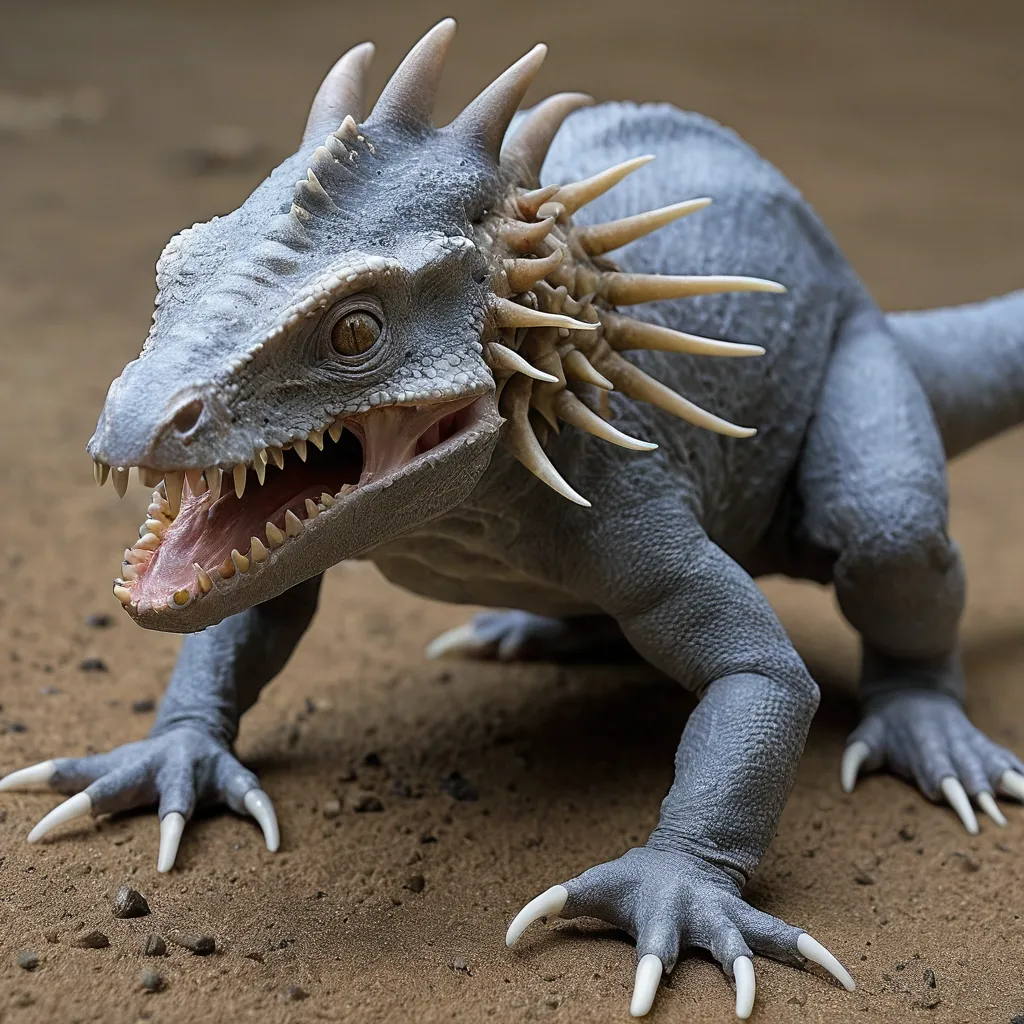
The genome of Tyrannosaurus rex , Triceratops and Giganotosaurus was used as the base genome for the hybrid. Including the shape of the head in some parts from Triceratops. Utahraptor DNA was added for high levels of intelligence and the ability to make plans , decisions and pack hunting. Reduced hind legs and Ape DNA added Knuckle-walking Quadruped. Triceratops , and Scelidosaurus were added to act as a biological form of armor that absorbed most of the incoming attacks. Northern short-tailed shrew , the Inland taipan's retractable fangs and the Komodo Dragon DNA was used to form the teeth of the Indominus that were used to tear through the flesh and armor of opponents. Saurophaganax and Gigantopithecus DNA added the presence of long strong arms with slashing hook claws and the use of tools. A swipe of the hybrid's claws would take down bigger opponents. While using tools for smaller elusive prey. Cuttlefish genes were intended to help the Venenosus withstand an accelerated growth , but it also added chromatophore cells in the skin so it could change the shape , color , and texture of its skin like a cuttlefish. Opossum , Mongoose and Tardigrades DNA was added for the Venenosus to be more resistant to climate changes , harmful toxins or bacterial infections , while tardigrades also added survival of extreme conditions such as exposure to extreme temperatures , extreme pressures , air deprivation , radiation , dehydration , and starvation. They have several defense mechanisms , including: A metabolic rate that gets as low as 0.01 percent of the normal rate. Organs protected by a sugary gel called trehalose. A protein that shields their DNA from radiation harm. Synthesis of cryoprotectant in chilly temperatures to prevent the development of ice crystals.Northern short-tailed shrew , the Inland Taipan , Greater blue-ringed octopus and the Komodo Dragon's DNA also added special cavities and glands in the skull that gave her infrared vision , and highly toxic saliva. Said DNA also gave her the ability to open her mandibles and jaws as wide as a snake , specifically at around 90 degrees.Lastly , DNA from a whiptail lizard was added for reproduction purposes. ,
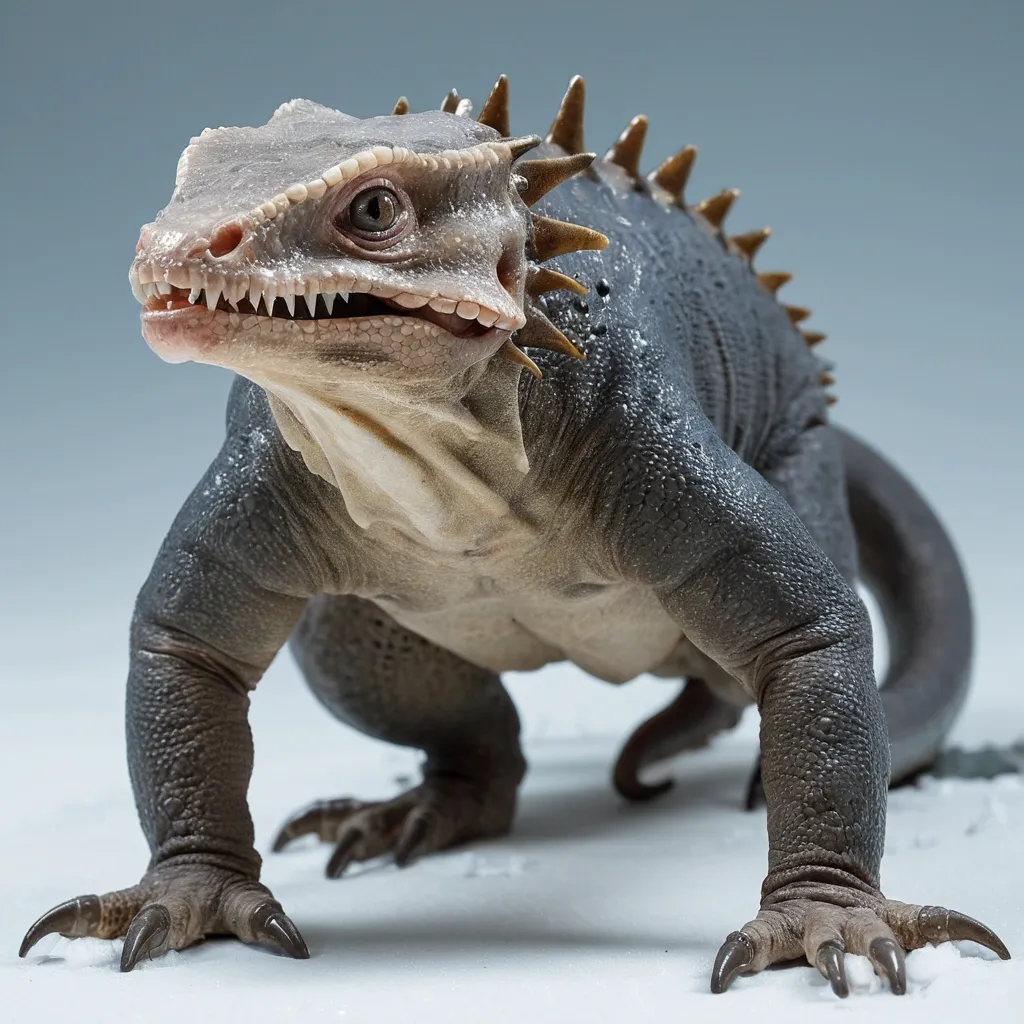
The genome of Tyrannosaurus rex , Triceratops and Giganotosaurus was used as the base genome for the hybrid. Including the shape of the head in some parts from Triceratops. Utahraptor DNA was added for high levels of intelligence and the ability to make plans , decisions and pack hunting. Reduced hind legs and Ape DNA added Knuckle-walking Quadruped. Triceratops , and Scelidosaurus were added to act as a biological form of armor that absorbed most of the incoming attacks. Northern short-tailed shrew , the Inland taipan's retractable fangs and the Komodo Dragon DNA was used to form the teeth of the Indominus that were used to tear through the flesh and armor of opponents. Saurophaganax and Gigantopithecus DNA added the presence of long strong arms with slashing hook claws and the use of tools. A swipe of the hybrid's claws would take down bigger opponents. While using tools for smaller elusive prey. Cuttlefish genes were intended to help the Venenosus withstand an accelerated growth , but it also added chromatophore cells in the skin so it could change the shape , color , and texture of its skin like a cuttlefish. Opossum , Mongoose and Tardigrades DNA was added for the Venenosus to be more resistant to climate changes , harmful toxins or bacterial infections , while tardigrades also added survival of extreme conditions such as exposure to extreme temperatures , extreme pressures , air deprivation , radiation , dehydration , and starvation. They have several defense mechanisms , including: A metabolic rate that gets as low as 0.01 percent of the normal rate. Organs protected by a sugary gel called trehalose. A protein that shields their DNA from radiation harm. Synthesis of cryoprotectant in chilly temperatures to prevent the development of ice crystals.Northern short-tailed shrew , the Inland Taipan , Greater blue-ringed octopus and the Komodo Dragon's DNA also added special cavities and glands in the skull that gave her infrared vision , and highly toxic saliva. Said DNA also gave her the ability to open her mandibles and jaws as wide as a snake , specifically at around 90 degrees.Lastly , DNA from a whiptail lizard was added for reproduction purposes. ,
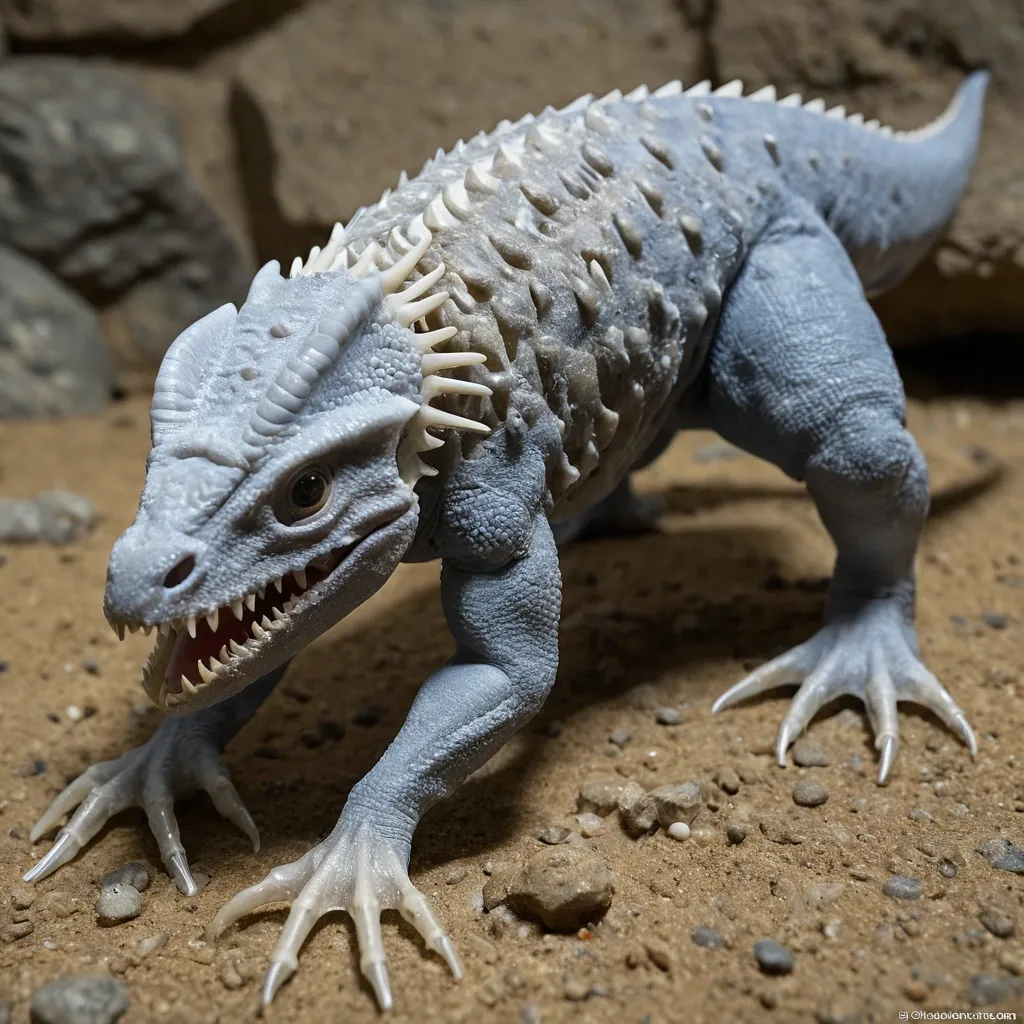
The genome of Tyrannosaurus rex , Triceratops and Giganotosaurus was used as the base genome for the hybrid. Including the shape of the head in some parts from Triceratops. Utahraptor DNA was added for high levels of intelligence and the ability to make plans , decisions and pack hunting. Reduced hind legs and Ape DNA added Knuckle-walking Quadruped. Triceratops , and Scelidosaurus were added to act as a biological form of armor that absorbed most of the incoming attacks. Northern short-tailed shrew , the Inland taipan's retractable fangs and the Komodo Dragon DNA was used to form the teeth of the Indominus that were used to tear through the flesh and armor of opponents. Saurophaganax and Gigantopithecus DNA added the presence of long strong arms with slashing hook claws and the use of tools. A swipe of the hybrid's claws would take down bigger opponents. While using tools for smaller elusive prey. Cuttlefish genes were intended to help the Venenosus withstand an accelerated growth , but it also added chromatophore cells in the skin so it could change the shape , color , and texture of its skin like a cuttlefish. Opossum , Mongoose and Tardigrades DNA was added for the Venenosus to be more resistant to climate changes , harmful toxins or bacterial infections , while tardigrades also added survival of extreme conditions such as exposure to extreme temperatures , extreme pressures , air deprivation , radiation , dehydration , and starvation. They have several defense mechanisms , including: A metabolic rate that gets as low as 0.01 percent of the normal rate. Organs protected by a sugary gel called trehalose. A protein that shields their DNA from radiation harm. Synthesis of cryoprotectant in chilly temperatures to prevent the development of ice crystals.Northern short-tailed shrew , the Inland Taipan , Greater blue-ringed octopus and the Komodo Dragon's DNA also added special cavities and glands in the skull that gave her infrared vision , and highly toxic saliva. Said DNA also gave her the ability to open her mandibles and jaws as wide as a snake , specifically at around 90 degrees.Lastly , DNA from a whiptail lizard was added for reproduction purposes. ,
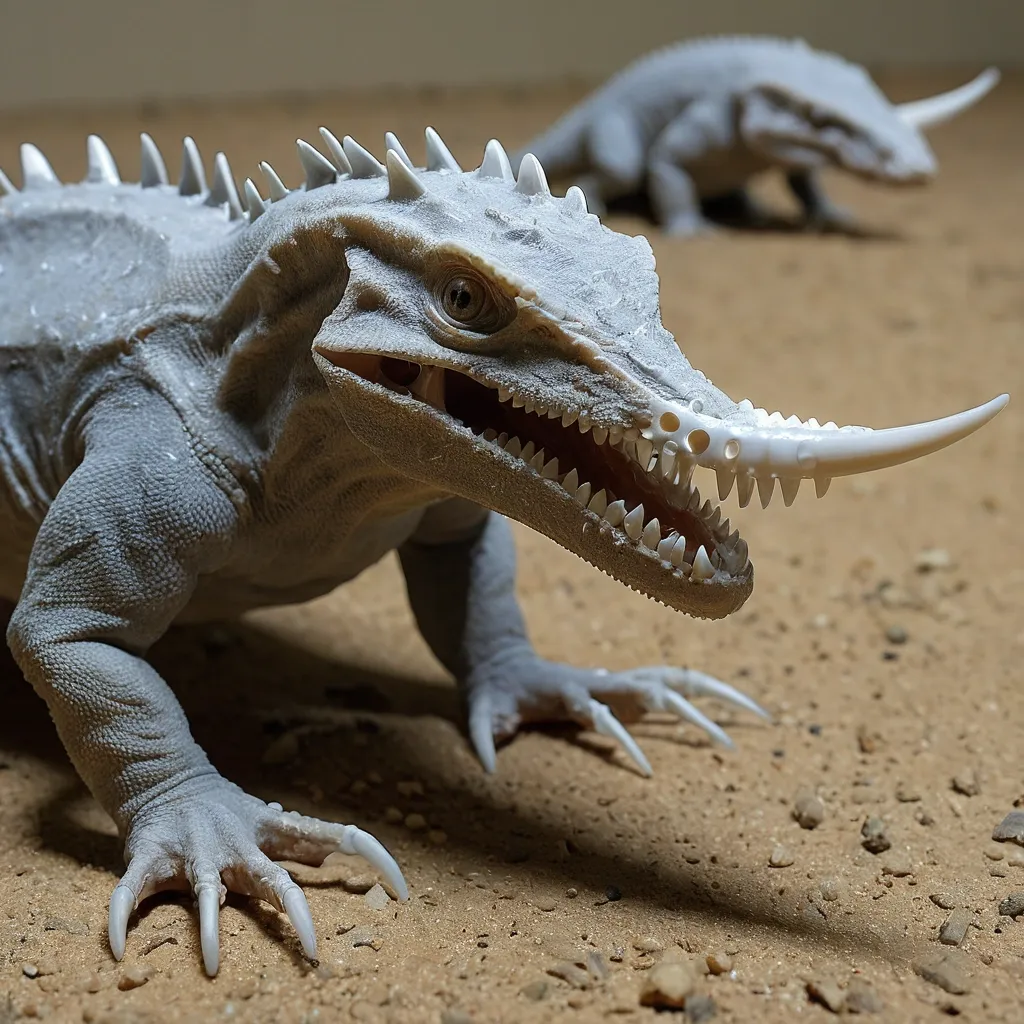
The genome of Tyrannosaurus rex , Triceratops and Giganotosaurus was used as the base genome for the hybrid. Including the shape of the head in some parts from Triceratops. Utahraptor DNA was added for high levels of intelligence and the ability to make plans , decisions and pack hunting. Reduced hind legs and Ape DNA added Knuckle-walking Quadruped. Triceratops , and Scelidosaurus were added to act as a biological form of armor that absorbed most of the incoming attacks. Northern short-tailed shrew , the Inland taipan's retractable fangs and the Komodo Dragon DNA was used to form the teeth of the Indominus that were used to tear through the flesh and armor of opponents. Saurophaganax and Gigantopithecus DNA added the presence of long strong arms with slashing hook claws and the use of tools. A swipe of the hybrid's claws would take down bigger opponents. While using tools for smaller elusive prey. Cuttlefish genes were intended to help the Venenosus withstand an accelerated growth , but it also added chromatophore cells in the skin so it could change the shape , color , and texture of its skin like a cuttlefish. Opossum , Mongoose and Tardigrades DNA was added for the Venenosus to be more resistant to climate changes , harmful toxins or bacterial infections , while tardigrades also added survival of extreme conditions such as exposure to extreme temperatures , extreme pressures , air deprivation , radiation , dehydration , and starvation. They have several defense mechanisms , including: A metabolic rate that gets as low as 0.01 percent of the normal rate. Organs protected by a sugary gel called trehalose. A protein that shields their DNA from radiation harm. Synthesis of cryoprotectant in chilly temperatures to prevent the development of ice crystals.Northern short-tailed shrew , the Inland Taipan , Greater blue-ringed octopus and the Komodo Dragon's DNA also added special cavities and glands in the skull that gave her infrared vision , and highly toxic saliva. Said DNA also gave her the ability to open her mandibles and jaws as wide as a snake , specifically at around 90 degrees.Lastly , DNA from a whiptail lizard was added for reproduction purposes. ,
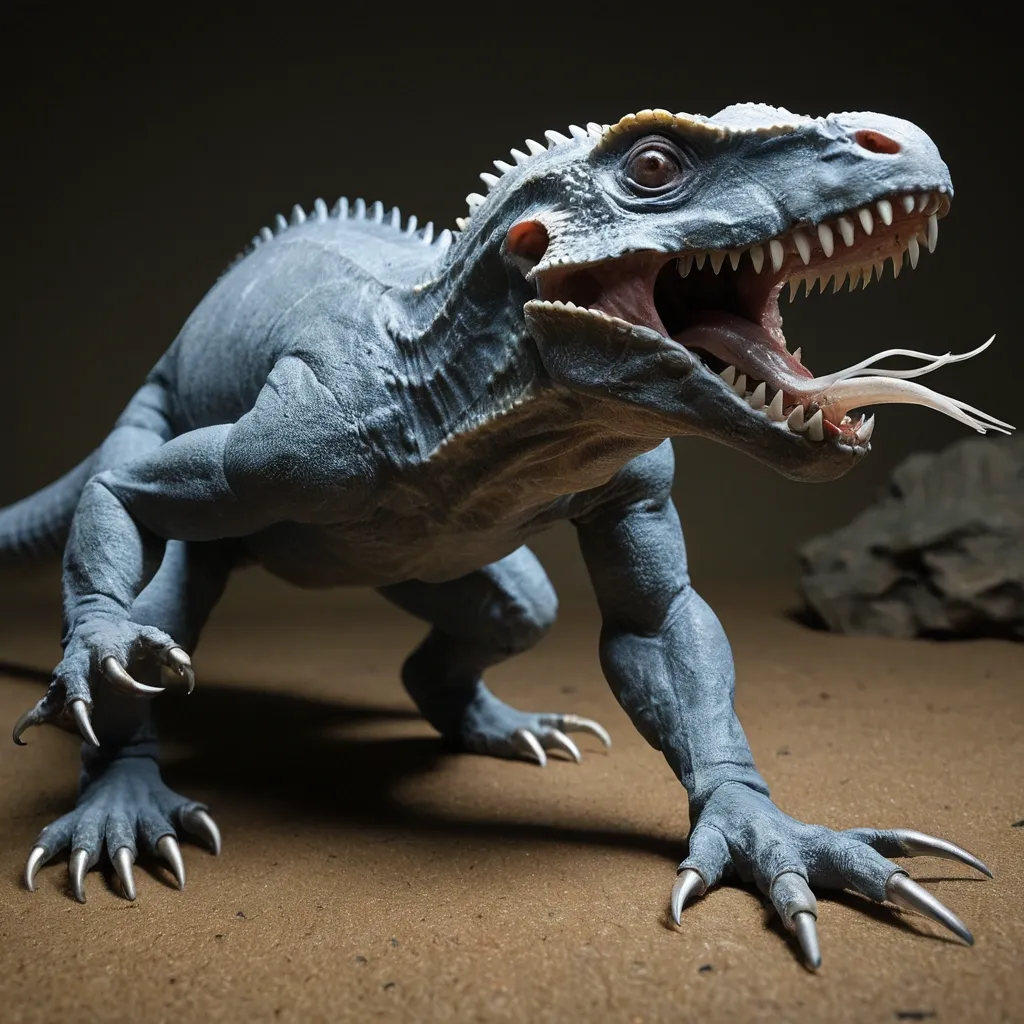
The genome of Tyrannosaurus rex , Triceratops and Giganotosaurus was used as the base genome for the hybrid. Including the shape of the head in some parts from Giganotosaurus and Triceratops. It also gave the Indominus rex an incredibly strong bite that could crush bulletproof glass. Utahraptor DNA was added for high levels of intelligence and the ability to make plans , decisions and pack hunting. Reduced hind legs and Ape DNA added Knuckle-walking Quadruped. Triceratops , and Scelidosaurus were added to act as a biological form of armor that absorbed most of the incoming attacks. Northern short-tailed shrew , the Inland taipan's retractable fangs and the Komodo Dragon DNA was used to form the teeth of the Indominus that were used to tear through the flesh and armor of opponents. Saurophaganax and Gigantopithecus DNA added the presence of long strong arms with slashing hook claws and the use of tools. A swipe of the hybrid's claws would take down bigger opponents. While using tools for smaller elusive prey. Cuttlefish genes were intended to help the Venenosus withstand an accelerated growth , but it also added chromatophore cells in the skin so it could change the shape , color , and texture of its skin like a cuttlefish. Opossum , Mongoose and Tardigrades DNA was added for the Venenosus to be more resistant to climate changes , harmful toxins or bacterial infections , while tardigrades also added survival of extreme conditions such as exposure to extreme temperatures , extreme pressures , air deprivation , radiation , dehydration , and starvation. They have several defense mechanisms , including: A metabolic rate that gets as low as 0.01 percent of the normal rate. Organs protected by a sugary gel called trehalose. A protein that shields their DNA from radiation harm. Synthesis of cryoprotectant in chilly temperatures to prevent the development of ice crystals.Northern short-tailed shrew , the Inland Taipan , Greater blue-ringed octopus and the Komodo Dragon's DNA also added special cavities and glands in the skull that gave her infrared vision , and highly toxic saliva. Said DNA also gave her the ability to open her mandibles and jaws as wide as a snake , specifically at around 90 degrees.Lastly , DNA from a whiptail lizard was added for reproduction purposes. ,
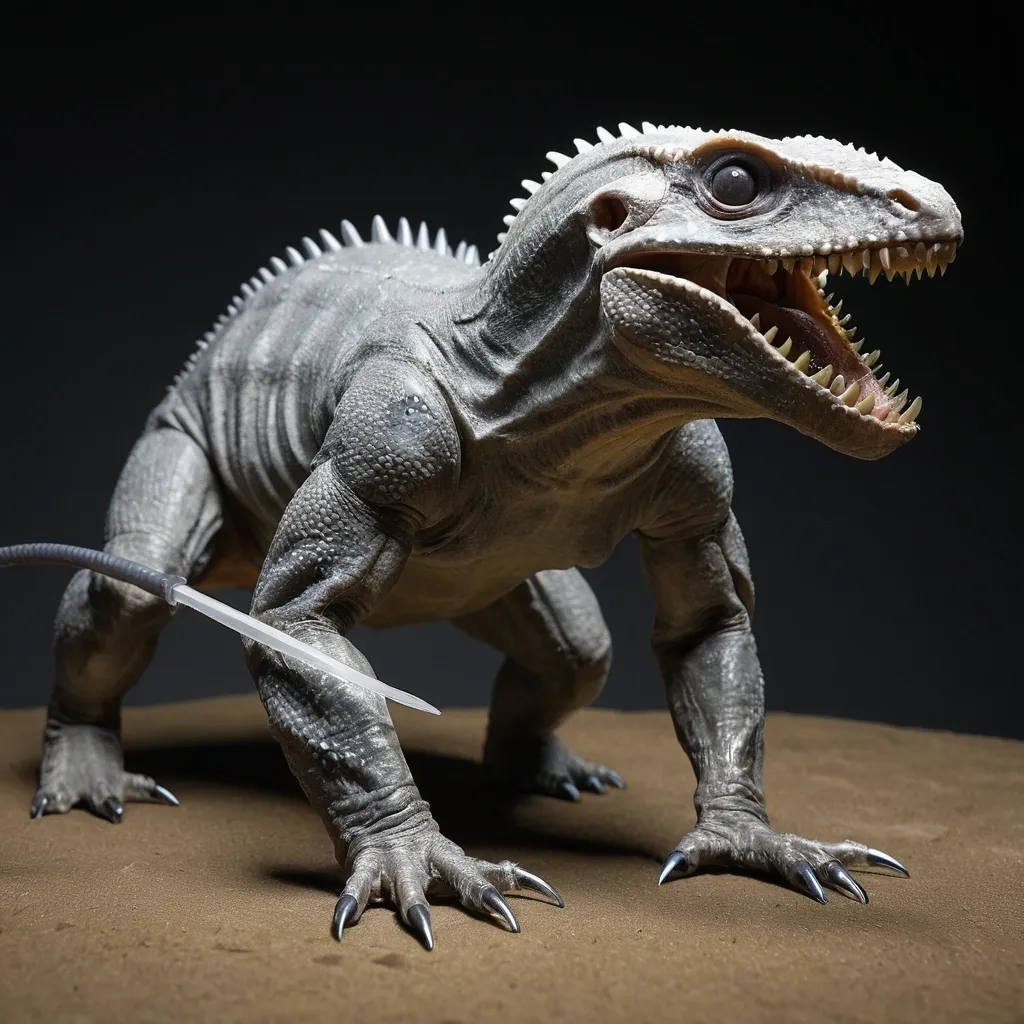
The genome of Tyrannosaurus rex , Triceratops and Giganotosaurus was used as the base genome for the hybrid. Including the shape of the head in some parts from Giganotosaurus and Triceratops. It also gave the Indominus rex an incredibly strong bite that could crush bulletproof glass. Utahraptor DNA was added for high levels of intelligence and the ability to make plans , decisions and pack hunting. Reduced hind legs and Ape DNA added Knuckle-walking Quadruped. Triceratops , and Scelidosaurus were added to act as a biological form of armor that absorbed most of the incoming attacks. Northern short-tailed shrew , the Inland taipan's retractable fangs and the Komodo Dragon DNA was used to form the teeth of the Indominus that were used to tear through the flesh and armor of opponents. Saurophaganax and Gigantopithecus DNA added the presence of long strong arms with slashing hook claws and the use of tools. A swipe of the hybrid's claws would take down bigger opponents. While using tools for smaller elusive prey. Cuttlefish genes were intended to help the Venenosus withstand an accelerated growth , but it also added chromatophore cells in the skin so it could change the shape , color , and texture of its skin like a cuttlefish. Opossum , Mongoose and Tardigrades DNA was added for the Venenosus to be more resistant to climate changes , harmful toxins or bacterial infections , while tardigrades also added survival of extreme conditions such as exposure to extreme temperatures , extreme pressures , air deprivation , radiation , dehydration , and starvation. They have several defense mechanisms , including: A metabolic rate that gets as low as 0.01 percent of the normal rate. Organs protected by a sugary gel called trehalose. A protein that shields their DNA from radiation harm. Synthesis of cryoprotectant in chilly temperatures to prevent the development of ice crystals.Northern short-tailed shrew , the Inland Taipan , Greater blue-ringed octopus and the Komodo Dragon's DNA also added special cavities and glands in the skull that gave her infrared vision , and highly toxic saliva. Said DNA also gave her the ability to open her mandibles and jaws as wide as a snake , specifically at around 90 degrees.Lastly , DNA from a whiptail lizard was added for reproduction purposes. ,
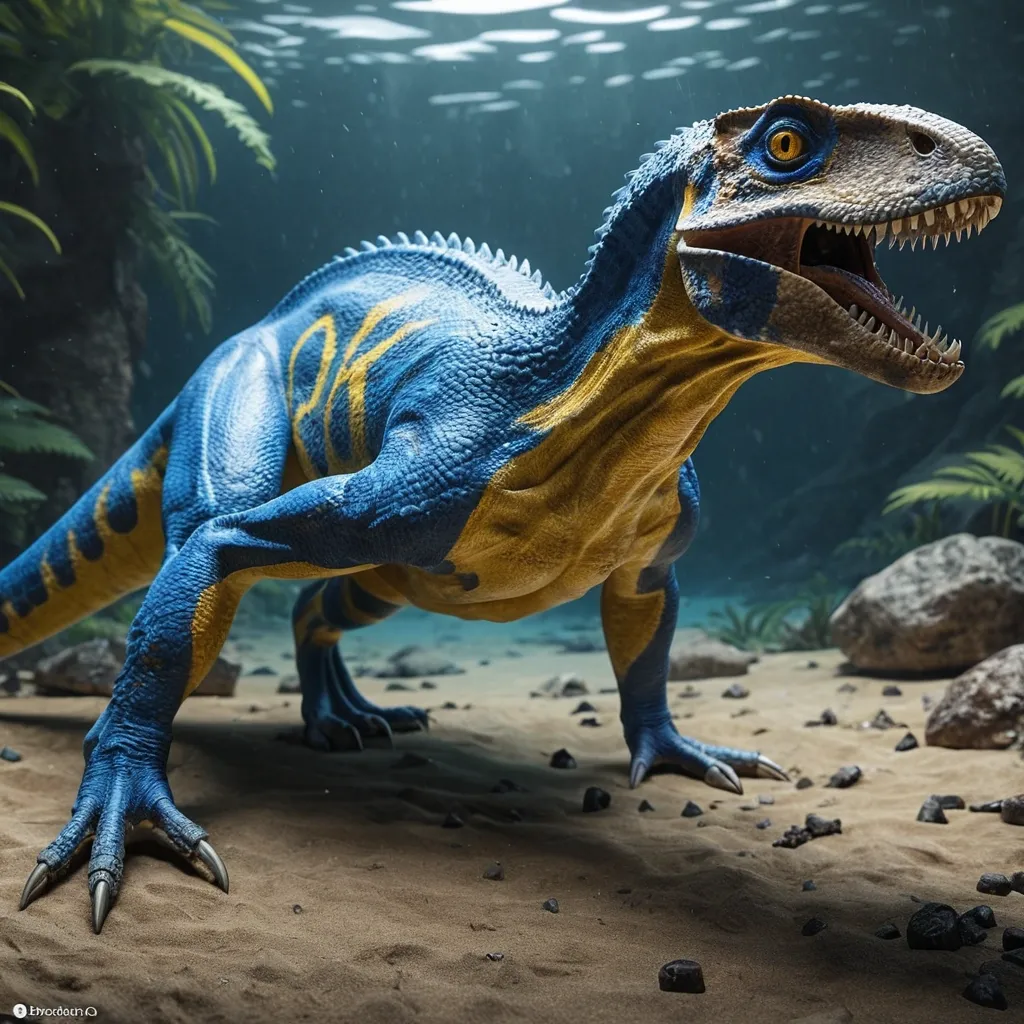
The hybrid was created by modifying the genome of a Tyrannosaurus rex , with the DNA of three other theropod species that were Utahraptor , Saurophaganax , and Giganotosaurus. Also the DNA of Quadrupes like Triceratops , and Scelidosaurus. DNA of modern animals such as Greater blue-ringed octopus , Inland Taipan , Northern Short-tailed Shrew , Komodo Dragon , Opossum , Mongoose , Gigantopithecus , Whiptail Lizard , Cuttlefish , and Tardigrades. The genome of Tyrannosaurus rex , Triceratops and Giganotosaurus was used as the base genome for the hybrid. Including the shape of the head in some parts from Giganotosaurus and Triceratops. It also gave the Indominus rex an incredibly strong bite that could crush bulletproof glass. Utahraptor DNA was added for high levels of intelligence and the ability to make plans , decisions and pack hunting. Reduced hind legs and Ape DNA added Knuckle-walking Quadruped. Triceratops , and Scelidosaurus were added to act as a biological form of armor that absorbed most of the incoming attacks. Northern short-tailed shrew , the Inland taipan's retractable fangs and the Komodo Dragon DNA was used to form the teeth of the Indominus that were used to tear through the flesh and armor of opponents. Saurophaganax and Gigantopithecus DNA added the presence of long strong arms with slashing hook claws and the use of tools. A swipe of the hybrid's claws would take down bigger opponents. While using tools for smaller elusive prey. Cuttlefish genes were intended to help the Venenosus withstand an accelerated growth , but it also added chromatophore cells in the skin so it could change the shape , color , and texture of its skin like a cuttlefish. Opossum , Mongoose and Tardigrades DNA was added for the Venenosus to be more resistant to climate changes , harmful toxins or bacterial infections , while tardigrades also added survival of extreme conditions such as exposure to extreme temperatures , extreme pressures , air deprivation , radiation , dehydration , and starvation. They have several defense mechanisms , including: A metabolic rate that gets as low as 0.01 percent of the normal rate. Organs protected by a sugary gel called trehalose. A protein that shields their DNA from radiation harm. Synthesis of cryoprotectant in chilly temperatures to prevent the development of ice crystals.Northern short-tailed shrew , the Inland Taipan , Greater blue-ringed octopus and the Komodo Dragon's DNA also added special cavities and glands in the skull that gave her infrared vision , and highly toxic saliva. Said DNA also gave her the ability to open her mandibles and jaws as wide as a snake , specifically at around 90 degrees.Lastly , DNA from a whiptail lizard was added for reproduction purposes. ,
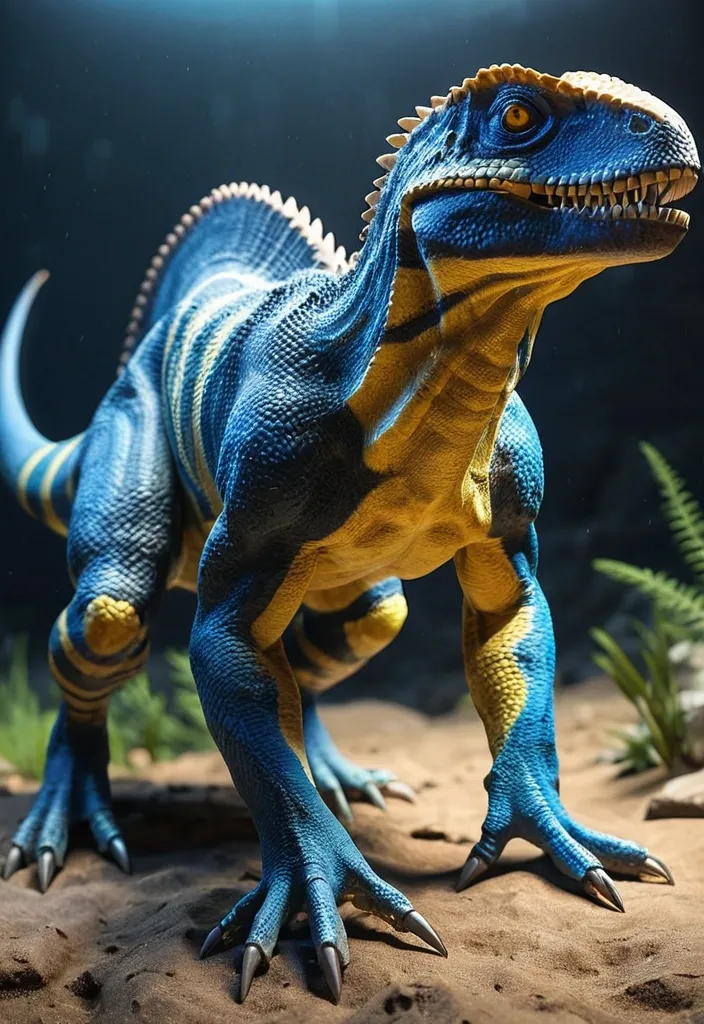
The hybrid was created by modifying the genome of a Tyrannosaurus rex , with the DNA of three other theropod species that were Utahraptor , Saurophaganax , and Giganotosaurus. Also the DNA of Quadrupes like Triceratops , and Scelidosaurus. DNA of modern animals such as Greater blue-ringed octopus , Inland Taipan , Northern Short-tailed Shrew , Komodo Dragon , Opossum , Mongoose , Gigantopithecus , Whiptail Lizard , Cuttlefish , and Tardigrades. The genome of Tyrannosaurus rex , Triceratops and Giganotosaurus was used as the base genome for the hybrid. Including the shape of the head in some parts from Giganotosaurus and Triceratops. It also gave the Indominus rex an incredibly strong bite that could crush bulletproof glass. Utahraptor DNA was added for high levels of intelligence and the ability to make plans , decisions and pack hunting. Reduced hind legs and Ape DNA added Knuckle-walking Quadruped. Triceratops , and Scelidosaurus were added to act as a biological form of armor that absorbed most of the incoming attacks. Northern short-tailed shrew , the Inland taipan's retractable fangs and the Komodo Dragon DNA was used to form the teeth of the Indominus that were used to tear through the flesh and armor of opponents. Saurophaganax and Gigantopithecus DNA added the presence of long strong arms with slashing hook claws and the use of tools. A swipe of the hybrid's claws would take down bigger opponents. While using tools for smaller elusive prey. Cuttlefish genes were intended to help the Venenosus withstand an accelerated growth , but it also added chromatophore cells in the skin so it could change the shape , color , and texture of its skin like a cuttlefish. Opossum , Mongoose and Tardigrades DNA was added for the Venenosus to be more resistant to climate changes , harmful toxins or bacterial infections , while tardigrades also added survival of extreme conditions such as exposure to extreme temperatures , extreme pressures , air deprivation , radiation , dehydration , and starvation. They have several defense mechanisms , including: A metabolic rate that gets as low as 0.01 percent of the normal rate. Organs protected by a sugary gel called trehalose. A protein that shields their DNA from radiation harm. Synthesis of cryoprotectant in chilly temperatures to prevent the development of ice crystals.Northern short-tailed shrew , the Inland Taipan , Greater blue-ringed octopus and the Komodo Dragon's DNA also added special cavities and glands in the skull that gave her infrared vision , and highly toxic saliva. Said DNA also gave her the ability to open her mandibles and jaws as wide as a snake , specifically at around 90 degrees.Lastly , DNA from a whiptail lizard was added for reproduction purposes. ,
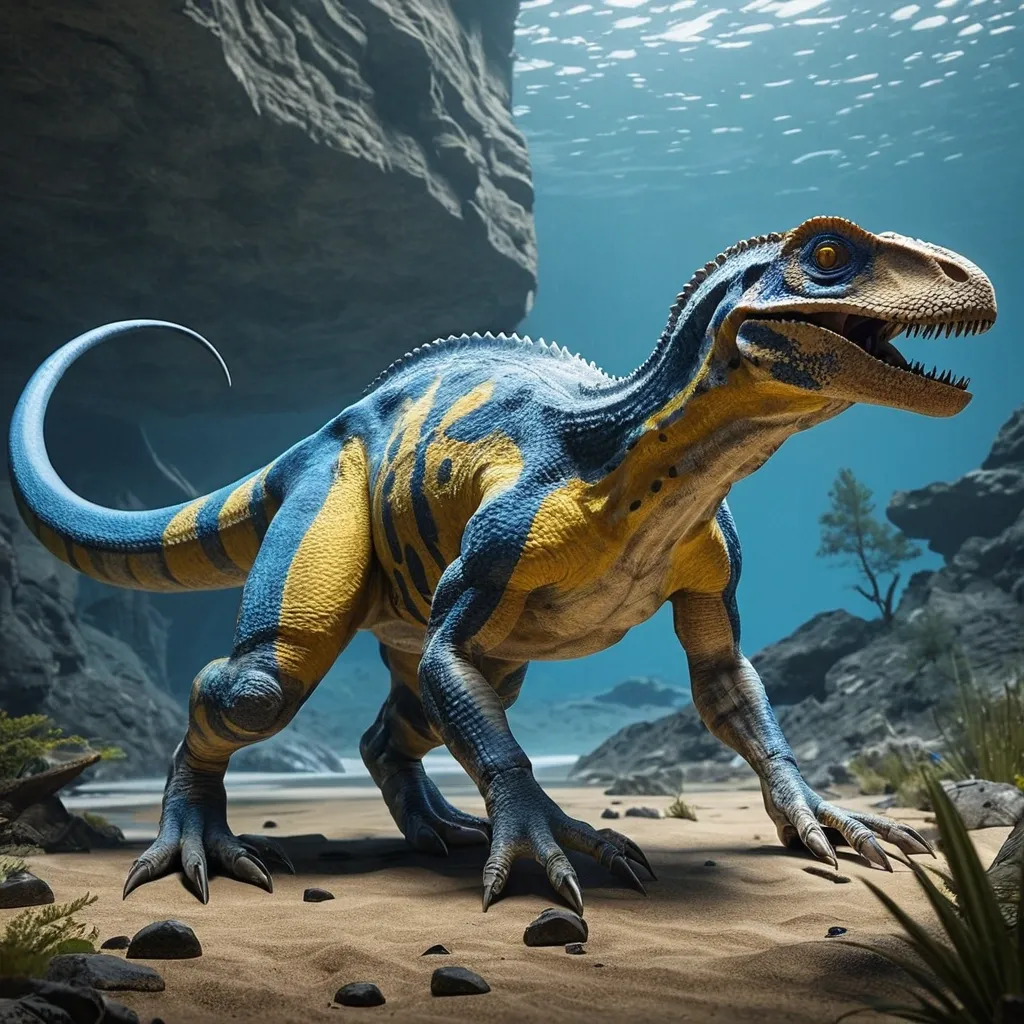
The hybrid was created by modifying the genome of a Tyrannosaurus rex , with the DNA of three other theropod species that were Utahraptor , Saurophaganax , and Giganotosaurus. Also the DNA of Quadrupes like Triceratops , and Scelidosaurus. DNA of modern animals such as Greater blue-ringed octopus , Inland Taipan , Northern Short-tailed Shrew , Komodo Dragon , Opossum , Mongoose , Gigantopithecus , Whiptail Lizard , Cuttlefish , and Tardigrades. The genome of Tyrannosaurus rex , Triceratops and Giganotosaurus was used as the base genome for the hybrid. Including the shape of the head in some parts from Giganotosaurus and Triceratops. It also gave the Indominus rex an incredibly strong bite that could crush bulletproof glass. Utahraptor DNA was added for high levels of intelligence and the ability to make plans , decisions and pack hunting. Reduced hind legs and Ape DNA added Knuckle-walking Quadruped. Triceratops , and Scelidosaurus were added to act as a biological form of armor that absorbed most of the incoming attacks. Northern short-tailed shrew , the Inland taipan's retractable fangs and the Komodo Dragon DNA was used to form the teeth of the Indominus that were used to tear through the flesh and armor of opponents. Saurophaganax and Gigantopithecus DNA added the presence of long strong arms with slashing hook claws and the use of tools. A swipe of the hybrid's claws would take down bigger opponents. While using tools for smaller elusive prey. Cuttlefish genes were intended to help the Venenosus withstand an accelerated growth , but it also added chromatophore cells in the skin so it could change the shape , color , and texture of its skin like a cuttlefish. Opossum , Mongoose and Tardigrades DNA was added for the Venenosus to be more resistant to climate changes , harmful toxins or bacterial infections , while tardigrades also added survival of extreme conditions such as exposure to extreme temperatures , extreme pressures , air deprivation , radiation , dehydration , and starvation. They have several defense mechanisms , including: A metabolic rate that gets as low as 0.01 percent of the normal rate. Organs protected by a sugary gel called trehalose. A protein that shields their DNA from radiation harm. Synthesis of cryoprotectant in chilly temperatures to prevent the development of ice crystals.Northern short-tailed shrew , the Inland Taipan , Greater blue-ringed octopus and the Komodo Dragon's DNA also added special cavities and glands in the skull that gave her infrared vision , and highly toxic saliva. Said DNA also gave her the ability to open her mandibles and jaws as wide as a snake , specifically at around 90 degrees.Lastly , DNA from a whiptail lizard was added for reproduction purposes. ,
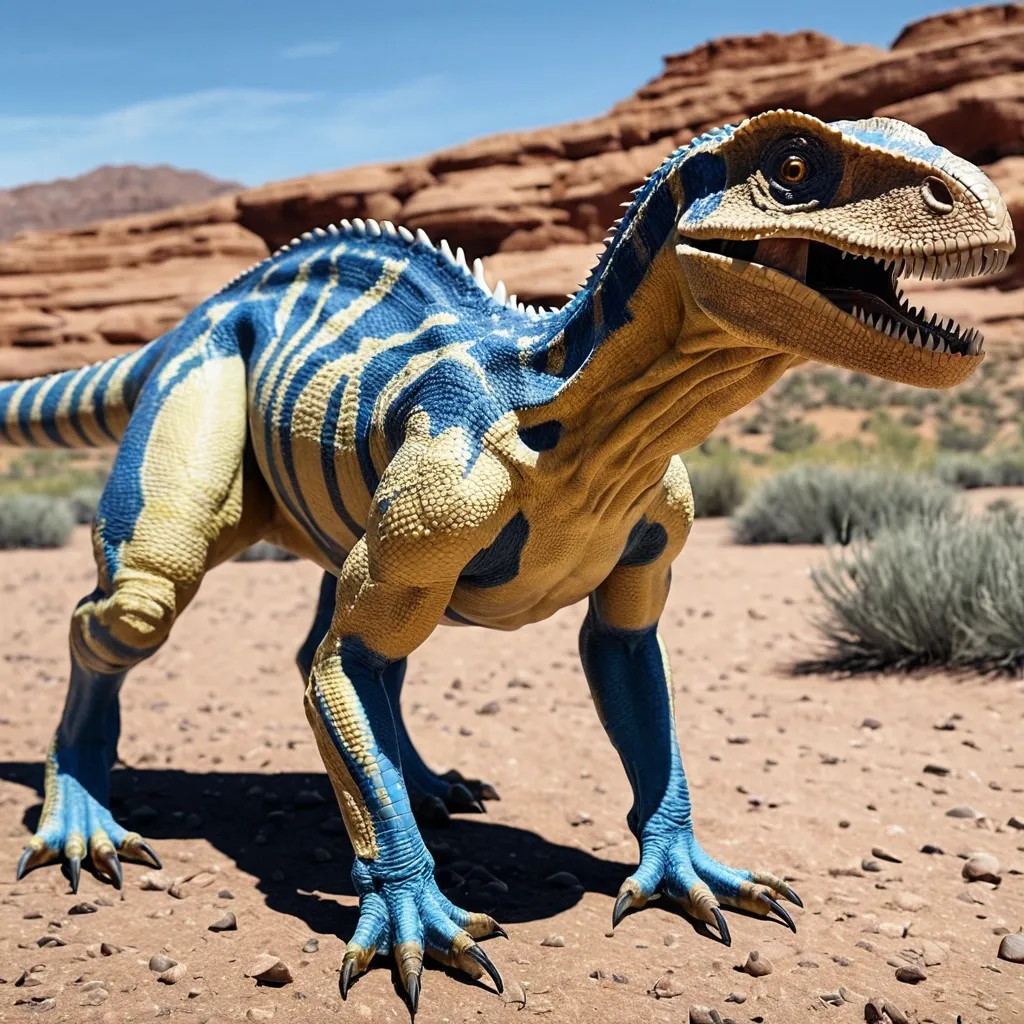
The hybrid was created by modifying the genome of a Tyrannosaurus rex , with the DNA of three other theropod species that were Utahraptor , Saurophaganax , and Giganotosaurus. Also the DNA of Quadrupes like Triceratops , and Scelidosaurus. DNA of modern animals such as Greater blue-ringed octopus , Inland Taipan , Northern Short-tailed Shrew , Komodo Dragon , Opossum , Mongoose , Gigantopithecus , Whiptail Lizard , Cuttlefish , and Tardigrades. The genome of Tyrannosaurus rex , Triceratops and Giganotosaurus was used as the base genome for the hybrid. Including the shape of the head in some parts from Giganotosaurus and Triceratops. It also gave the Indominus rex an incredibly strong bite that could crush bulletproof glass. Utahraptor DNA was added for high levels of intelligence and the ability to make plans , decisions and pack hunting. Reduced hind legs and Ape DNA added Knuckle-walking Quadruped. Triceratops , and Scelidosaurus were added to act as a biological form of armor that absorbed most of the incoming attacks. Northern short-tailed shrew , the Inland taipan's retractable fangs and the Komodo Dragon DNA was used to form the teeth of the Indominus that were used to tear through the flesh and armor of opponents. Saurophaganax and Gigantopithecus DNA added the presence of long strong arms with slashing hook claws and the use of tools. A swipe of the hybrid's claws would take down bigger opponents. While using tools for smaller elusive prey. Cuttlefish genes were intended to help the Venenosus withstand an accelerated growth , but it also added chromatophore cells in the skin so it could change the shape , color , and texture of its skin like a cuttlefish. Opossum , Mongoose and Tardigrades DNA was added for the Venenosus to be more resistant to climate changes , harmful toxins or bacterial infections , while tardigrades also added survival of extreme conditions such as exposure to extreme temperatures , extreme pressures , air deprivation , radiation , dehydration , and starvation. They have several defense mechanisms , including: A metabolic rate that gets as low as 0.01 percent of the normal rate. Organs protected by a sugary gel called trehalose. A protein that shields their DNA from radiation harm. Synthesis of cryoprotectant in chilly temperatures to prevent the development of ice crystals.Northern short-tailed shrew , the Inland Taipan , Greater blue-ringed octopus and the Komodo Dragon's DNA also added special cavities and glands in the skull that gave her infrared vision , and highly toxic saliva. Said DNA also gave her the ability to open her mandibles and jaws as wide as a snake , specifically at around 90 degrees.Lastly , DNA from a whiptail lizard was added for reproduction purposes. ,
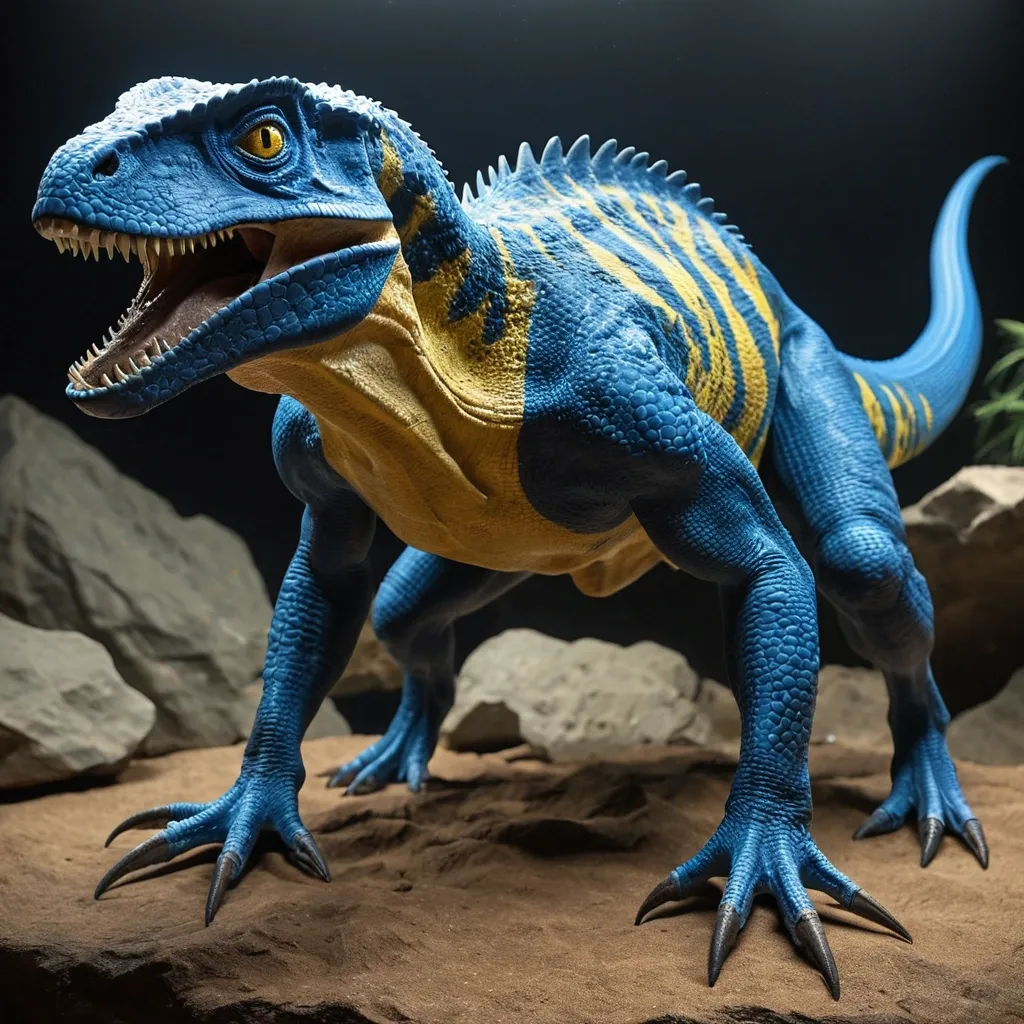
The hybrid was created by modifying the genome of a Tyrannosaurus rex , with the DNA of three other theropod species that were Utahraptor , Saurophaganax , and Giganotosaurus. Also the DNA of Quadrupes like Triceratops , and Scelidosaurus. DNA of modern animals such as Greater blue-ringed octopus , Inland Taipan , Northern Short-tailed Shrew , Komodo Dragon , Opossum , Mongoose , Ape , Whiptail Lizard , Cuttlefish , and Tardigrades. The genome of Tyrannosaurus rex , Triceratops and Giganotosaurus was used as the base genome for the hybrid. Including the shape of the head in some parts from Giganotosaurus and Triceratops. It also gave the Indominus rex an incredibly strong bite that could crush bulletproof glass. Utahraptor DNA was added for high levels of intelligence and the ability to make plans , decisions and pack hunting. Reduced hind legs and Ape DNA added Knuckle-walking Quadruped. Triceratops , and Scelidosaurus were added to act as a biological form of armor that absorbed most of the incoming attacks. Northern short-tailed shrew , the Inland taipan's retractable fangs and the Komodo Dragon DNA was used to form the teeth of the Indominus that were used to tear through the flesh and armor of opponents. Saurophaganax and Gigantopithecus DNA added the presence of long strong arms with slashing hook claws and the use of tools. A swipe of the hybrid's claws would take down bigger opponents. While using tools for smaller elusive prey. Cuttlefish genes were intended to help the Venenosus withstand an accelerated growth , but it also added chromatophore cells in the skin so it could change the shape , color , and texture of its skin like a cuttlefish. Opossum , Mongoose and Tardigrades DNA was added for the Venenosus to be more resistant to climate changes , harmful toxins or bacterial infections , while tardigrades also added survival of extreme conditions such as exposure to extreme temperatures , extreme pressures , air deprivation , radiation , dehydration , and starvation. They have several defense mechanisms , including: A metabolic rate that gets as low as 0.01 percent of the normal rate. Organs protected by a sugary gel called trehalose. A protein that shields their DNA from radiation harm. Synthesis of cryoprotectant in chilly temperatures to prevent the development of ice crystals.Northern short-tailed shrew , the Inland Taipan , Greater blue-ringed octopus and the Komodo Dragon's DNA also added special cavities and glands in the skull that gave her infrared vision , and highly toxic saliva. Said DNA also gave her the ability to open her mandibles and jaws as wide as a snake , specifically at around 90 degrees.Lastly , DNA from a whiptail lizard was added for reproduction purposes. ,
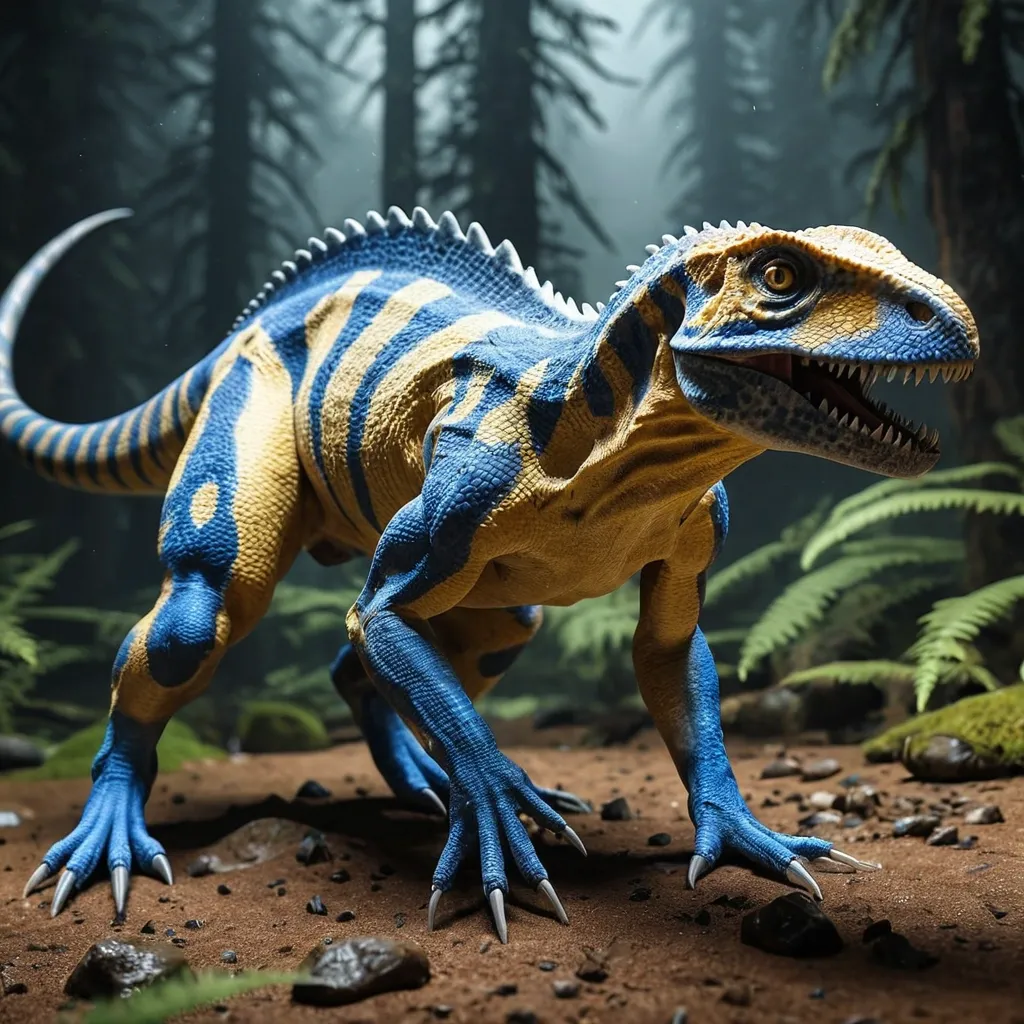
The hybrid was created by modifying the genome of a Tyrannosaurus rex , with the DNA of three other theropod species that were Utahraptor , Saurophaganax , and Giganotosaurus. Also the DNA of Quadrupes like Triceratops , and Scelidosaurus. DNA of modern animals such as Greater blue-ringed octopus , Inland Taipan , Northern Short-tailed Shrew , Komodo Dragon , Opossum , Mongoose , Ape , Whiptail Lizard , Cuttlefish , and Tardigrades. The genome of Tyrannosaurus rex , Triceratops and Giganotosaurus was used as the base genome for the hybrid. Including the shape of the head in some parts from Giganotosaurus and Triceratops. It also gave the Indominus rex an incredibly strong bite that could crush bulletproof glass. Utahraptor DNA was added for high levels of intelligence and the ability to make plans , decisions and pack hunting. Reduced hind legs and Ape DNA added Knuckle-walking Quadruped. Triceratops , and Scelidosaurus were added to act as a biological form of armor that absorbed most of the incoming attacks. Northern short-tailed shrew , the Inland taipan's retractable fangs and the Komodo Dragon DNA was used to form the teeth of the Indominus that were used to tear through the flesh and armor of opponents. Saurophaganax and Ape DNA added the presence of long strong arms with slashing hook claws and the use of tools. A swipe of the hybrid's claws would take down bigger opponents. While using tools for smaller elusive prey. Cuttlefish genes were intended to help the Venenosus withstand an accelerated growth , but it also added chromatophore cells in the skin so it could change the shape , color , and texture of its skin like a cuttlefish. Opossum , Mongoose and Tardigrades DNA was added for the Venenosus to be more resistant to climate changes , harmful toxins or bacterial infections , while tardigrades also added survival of extreme conditions such as exposure to extreme temperatures , extreme pressures , air deprivation , radiation , dehydration , and starvation. They have several defense mechanisms , including: A metabolic rate that gets as low as 0.01 percent of the normal rate. Organs protected by a sugary gel called trehalose. A protein that shields their DNA from radiation harm. Synthesis of cryoprotectant in chilly temperatures to prevent the development of ice crystals.Northern short-tailed shrew , the Inland Taipan , Greater blue-ringed octopus and the Komodo Dragon's DNA also added special cavities and glands in the skull that gave her infrared vision , and highly toxic saliva. Said DNA also gave her the ability to open her mandibles and jaws as wide as a snake , specifically at around 90 degrees.Lastly , DNA from a whiptail lizard was added for reproduction purposes. ,
